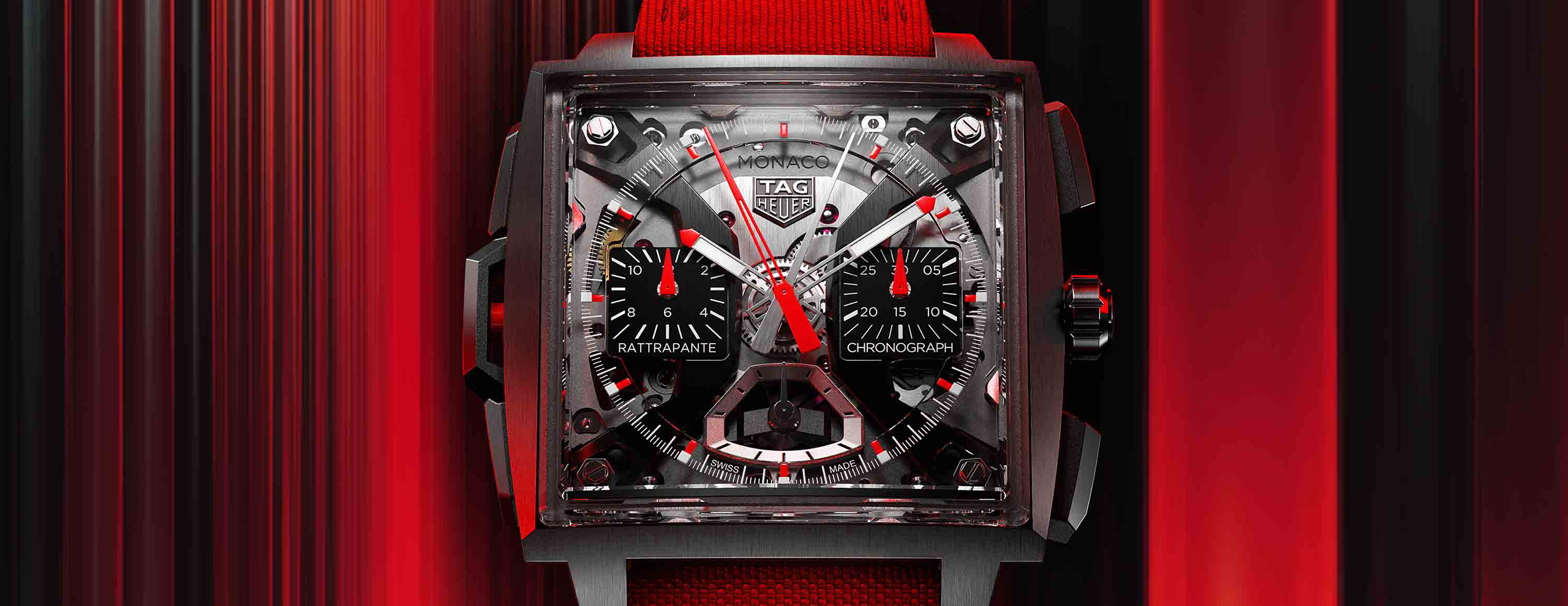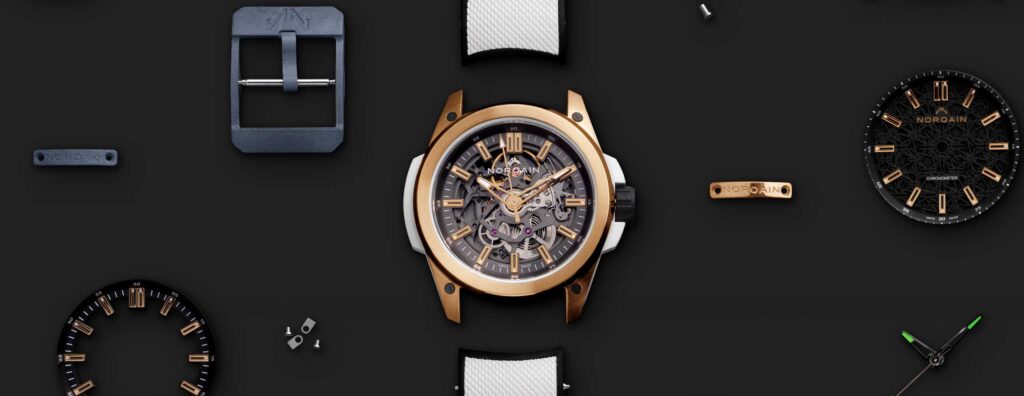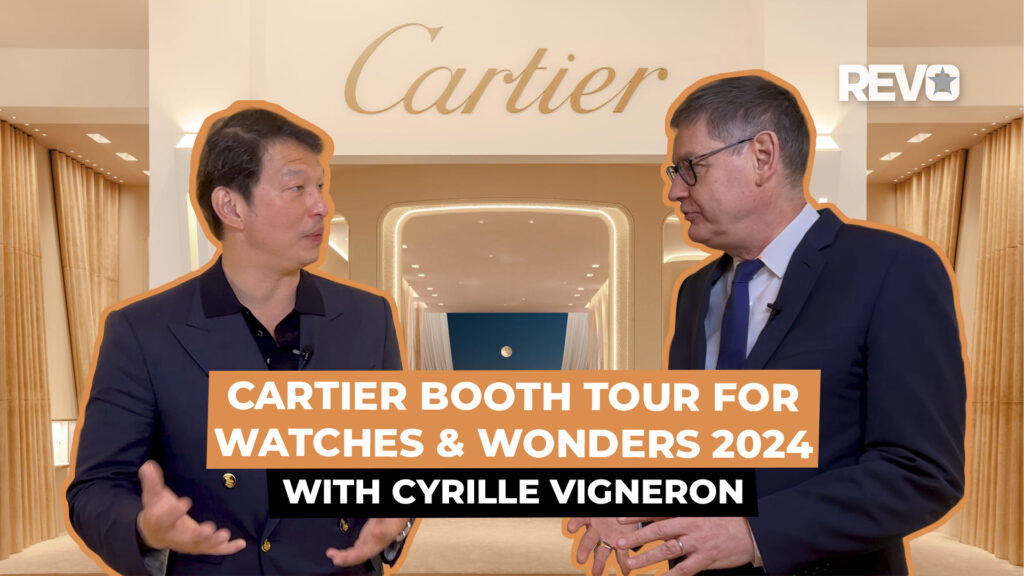After five years of intense R&D comes an haute horlogerie timepiece that draws deeply from the brand’s long heritage in precision timekeeping.
That
TAG Heuer shares a long and intricate relationship with the chronograph is a fact well known — and a story well documented — by many. Almost intuitively today, people associate the brand with sporty timekeepers distilled from the world of automotive racing and designed for everyday wear. Yet what would seem less universally understood is precisely how long and exactly how intricate this relationship is. The introduction of the TAG Heuer Monaco Split-Seconds Chronograph this year makes it perfect timing to delve more deeply into why has TAG Heuer been so obsessed with the chronograph that the majority of its 164-year-long history has been devoted to precision timekeeping and creating ever more sophisticated ways to measure time.
Consider the company’s top two most iconic watches of all time. Indisputably, they are the
Carrera reference 2447 and the
Monaco reference 1133B. These watches were introduced as chronographs first, before time-only versions eventually entered the collections. As well for many horology enthusiasts past and present, the first TAG Heuer timepiece they had ever bought was a chronograph simply because no other complication could be more indelibly linked to TAG Heuer’s core identity as a watchmaker.
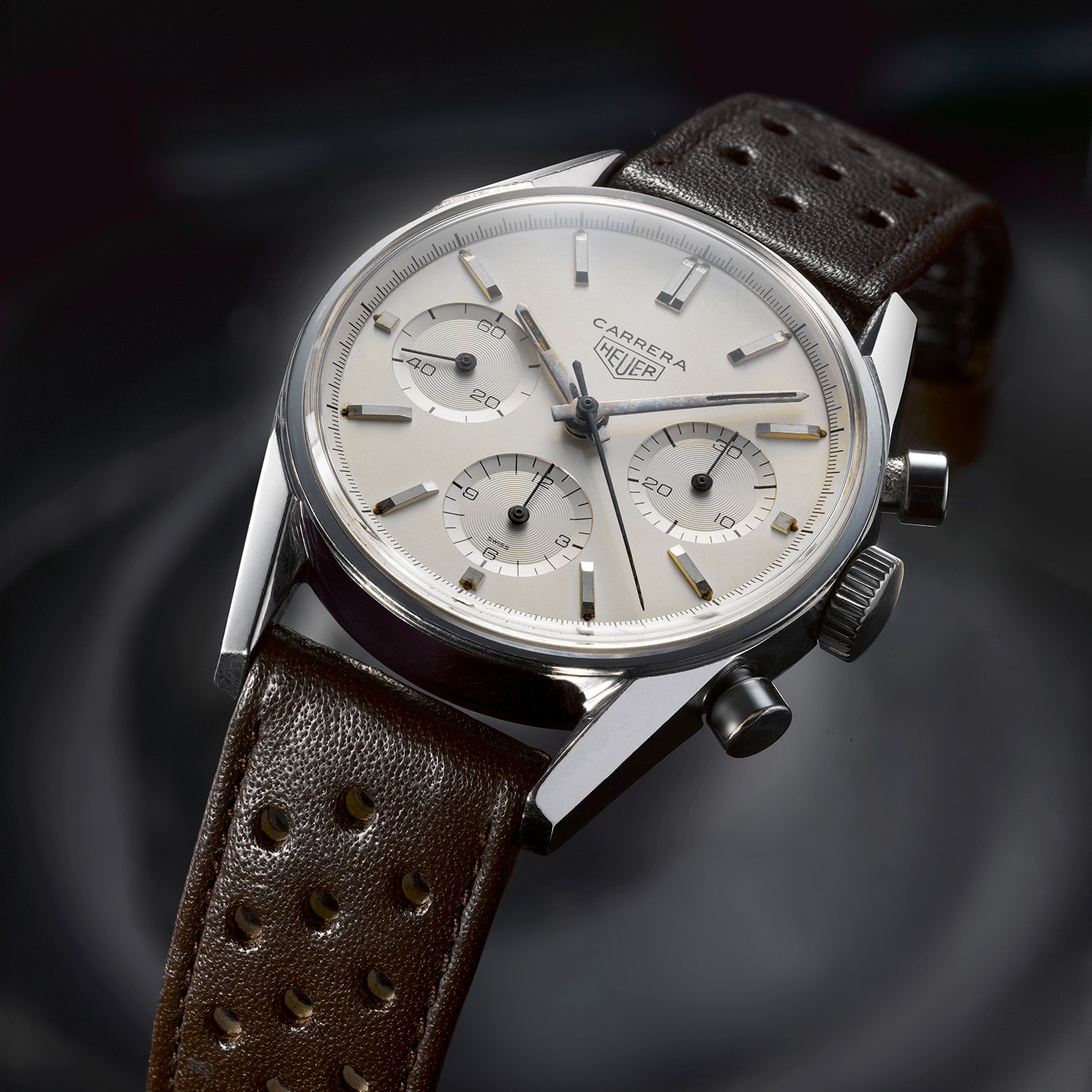
Heuer Carrera reference 2447
When the company released the first Carrera model in 1963 it relied on one of the best performing chronograph movements on the market, the manual-winding Valjoux 72, but for the Monaco in 1969, it went one step further to raise the stakes in precision timekeeping. Naturally this takes us back to the arrival of the world’s first automatic chronograph in 1969 when the company collaborated with a consortium that includes Breitling, Hamilton-Buren and Dubois Depraz, to produce the formidable
Monaco caliber 11 with its crown uniquely positioned at 9 o’clock. This was a moment forever etched in time.
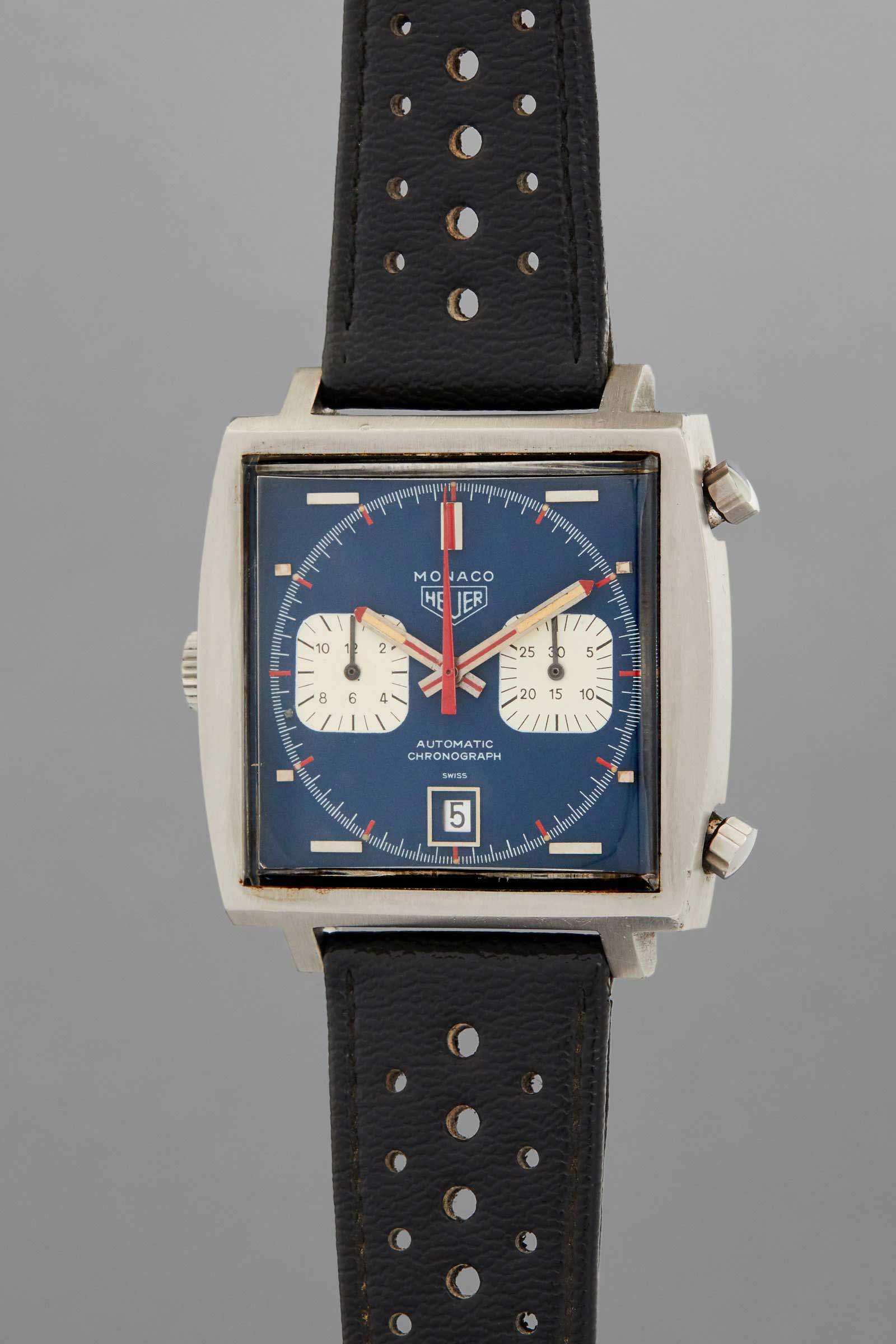
One of six Heuer Monaco watches used during the filming of Steve McQueen's 1970 film, Le mans to be auctioned by Phillips at 2020 New York sale, on 12 December (Image: phillipswatches)
And a year later when images circulated of
Steve McQueen wearing the Monaco 1133B on and around the set of the film
Le Mans, that was when the Monaco became an icon. Not to mention what a stroke of design genius it had been for
Jack Heuer to have worked with the Swiss case maker Erwin Piquerez on the world’s first square-shaped water resistant chronograph case, securing the Monaco a permanent place in the sports watches hall of fame for all eternity. Indeed, TAG Heuer has come an incredibly long way with the chronograph in every style, shape and configuration.
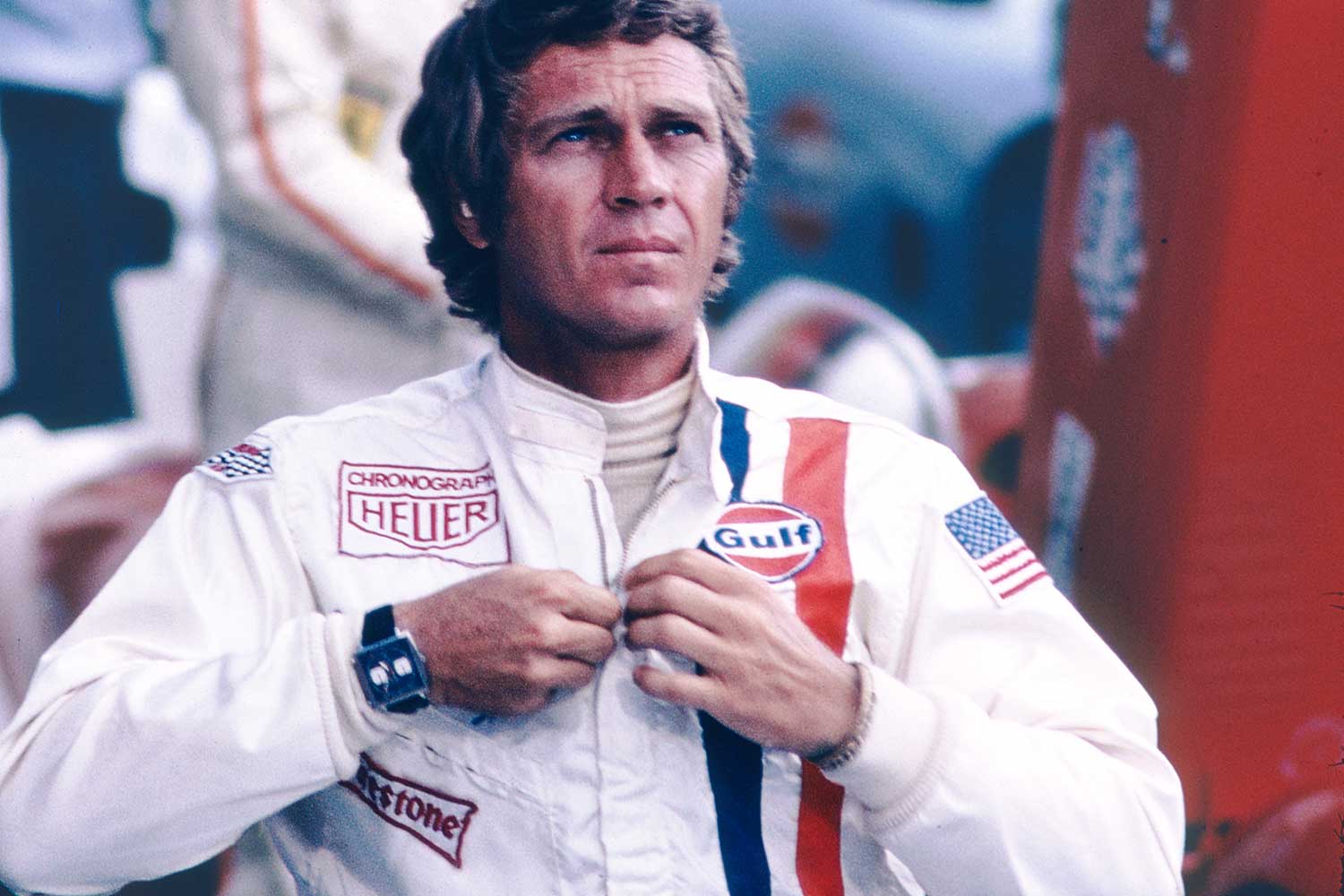
Steve McQueen wearing Monaco 1133B
But the journey continues well into the 21st century, and in an upward trajectory that recently culminated in its most complicated chronograph wrist-worn timepiece yet, the Monaco Split Seconds Chronograph.
This marvellous new timepiece is the latest expression of TAG Heuer’s rich heritage in producing precision timekeepers and a brilliant showcase of its utterly contemporary approach to haute horlogerie, which places quality, authenticity and reliability above all other aspects of the product. To fully appreciate this haute horlogerie chronograph, we must delve into TAG Heuer’s long and winding romance with automotive timekeeping as well as its avant-garde approach to modern watchmaking.
Automotive Timekeeping History
With a young and modern identity that is constantly refreshed and updated to appeal to a wide audience, it’s often easy to forget that TAG Heuer is a 164 year old brand company rooted in precision watchmaking. Since its founding in 1860, Uhrenmanufaktur Heuer AG, as the company was then known, has made numerous contributions to horology.
Its founder Edouard Heuer made his first pocket watch chronograph in 1882, and later on in 1887 improved the oscillating pinion chronograph, building upon the industry standard horizontal clutch chronograph. Heuer’s oscillating pinion simplified and improved chronograph wheel engagement and is, to date, the simplest, most practical and cost effective way to couple the going train on the main plate to the chronograph mechanism which is assembled on top.

Heuer Mikrograph
accurate to 1/100th of a second
Throughout the 20th century, the company devoted itself to researching and developing the latest in timekeeping technology, predominantly for the burgeoning automotive and aeronautical industries. In 1911 it debuted a dashboard mounted precision chronograph known as Time of Trip which featured separate dials, one for time of day and a sub-dial that recorded duration of a journey actuated via a pusher set within the crown. Next, Heuer’s first wristwatch chronograph appeared in 1914, a timepiece adapted from a pocket watch chronograph, and hence had the crown placed at 12 o’clock.
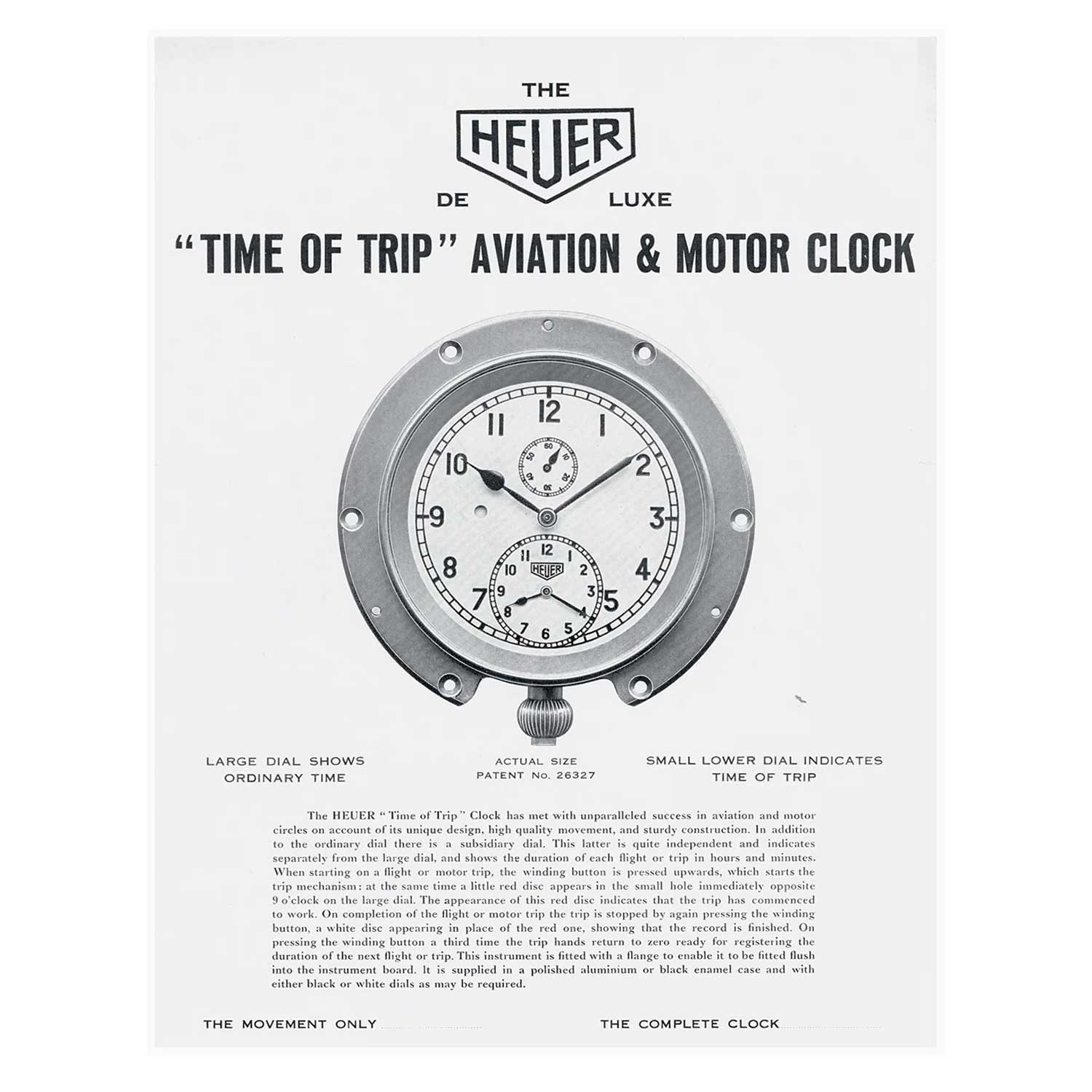
In addition to hours and minutes, Time of Trip recorded elapsed time for a specific journey
Indeed, the early 20th century was a beautiful era for TAG Heuer precision timekeepers. In 1916 Edouard Heuer’s son, Charles-Auguste, presented a stopwatch known as the Mikrograph which was the first commercially available timing device accurate to 1/100th of a second. This was then followed very quickly by a complementary product called the Mikrosplit which was a rattrapante version of the Mikrograph. A rattrapante as we know is the pinnacle of chronographs, with two chronograph seconds hands allowing for the measurement of two independent events that begin simultaneously but would conclude at different times. In addition to the Mikrograph and Mikrosplit, Heuer has also created the Semikrograph and Semikrosplit which were 1/50th of a second versions that were slightly more affordable, thus appealing to a wider audience.
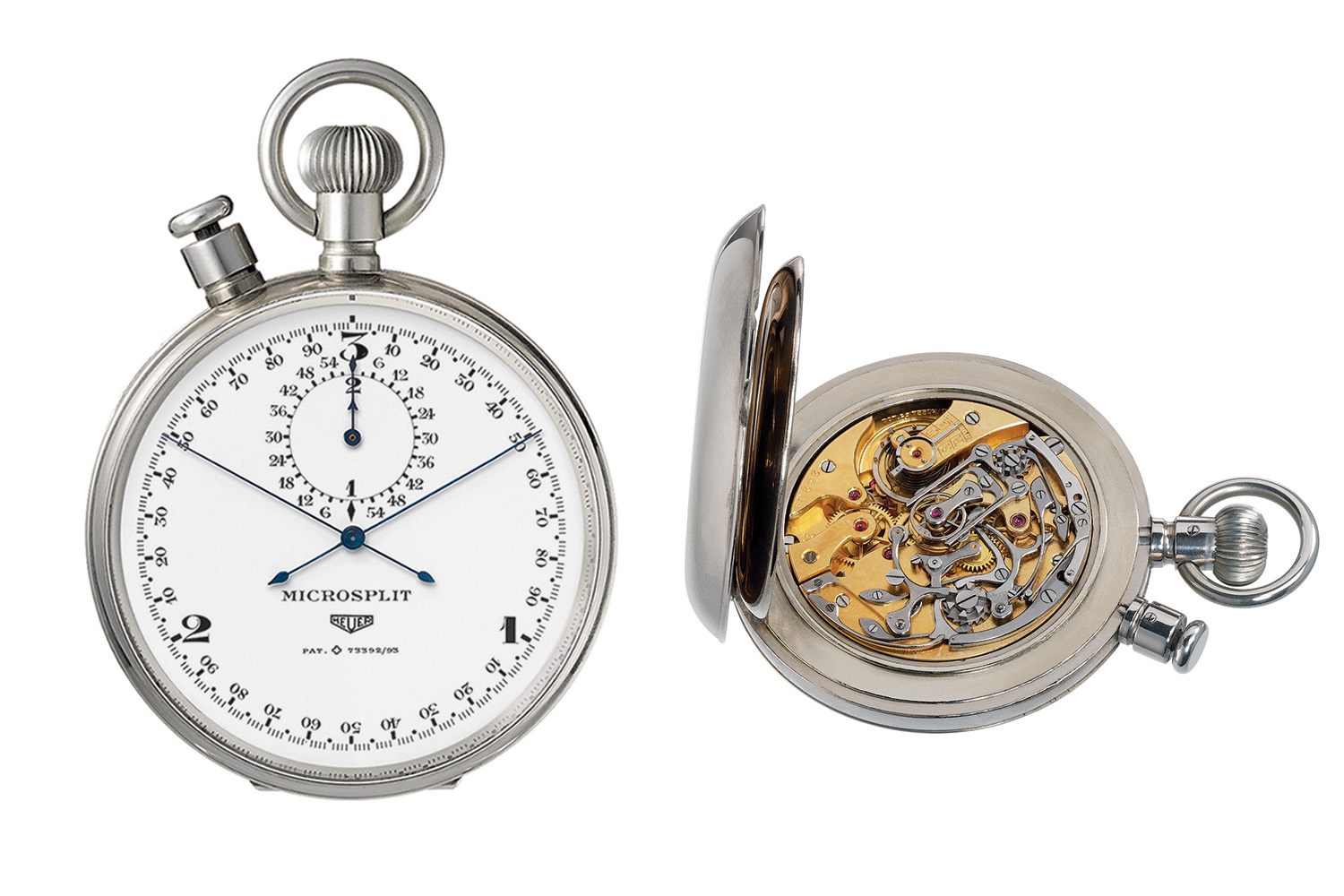
Introduced in the mid 1910s, the Heuer Mikrosplit is a rattrapante
stopwatch accurate to 1/100th of a second
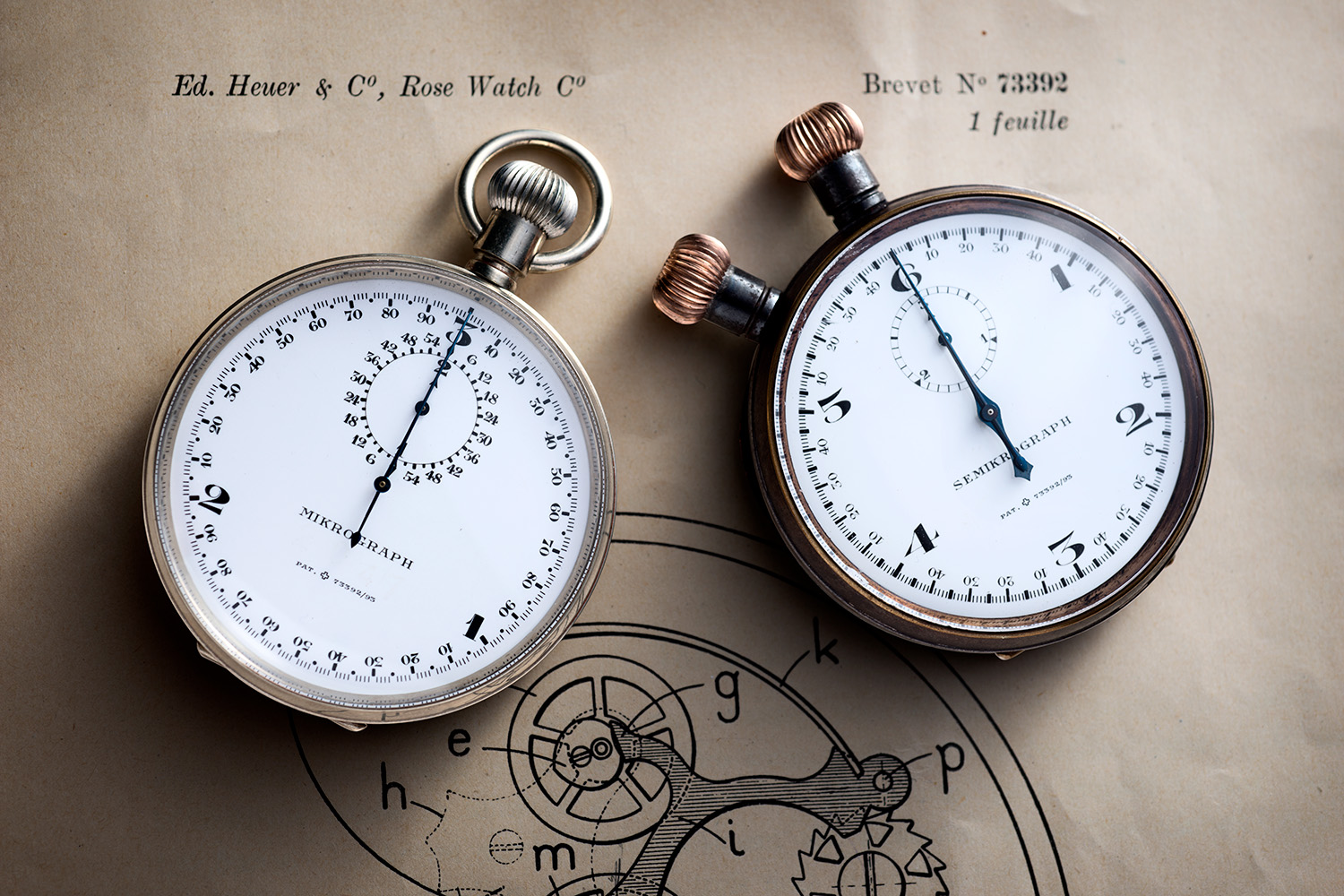
L to R: Heuer Mikrograph and Semikrograph
Says heritage director of TAG Heuer,
Nicholas Biebuyck, “We’re now celebrating the 164th year of the founding of what was originally Edouard Heuer and Co, then Heuer, then TAG Heuer. It’s important to remember that while every brand under the sun wants to talk about innovation and the chronograph and the connection to motorsport, we’re the only brand that can legitimately say that this is a fil rouge, which is extended throughout basically all the company history. From very early on, Edouard Heuer focused on the chronograph as a complication, and successive generations of the family would continue to pursue the chronograph. And of course, throughout the century of aviation and automobile technology, it was seen as a great discipline for the brand as well.”
These high precision timekeepers paved the way for more to follow as Heuer would soon come to release its famous reference 1201 split second chronograph pocket watch accurate to 1/5th of a second, and the much celebrated reference 11.402, which is a 1/10th of a second rattrapante chronograph pocket watch running on a Valjoux 9 manual-winding movement. Both were highly indispensable timekeeping devices, each contributing in their own small ways towards establishing the finest standards of chronometric precision as one would expect of motorsports, in particular, Formula One racing. And Heuer spared no effort in constructing its timekeepers, providing top quality inside as well as out.
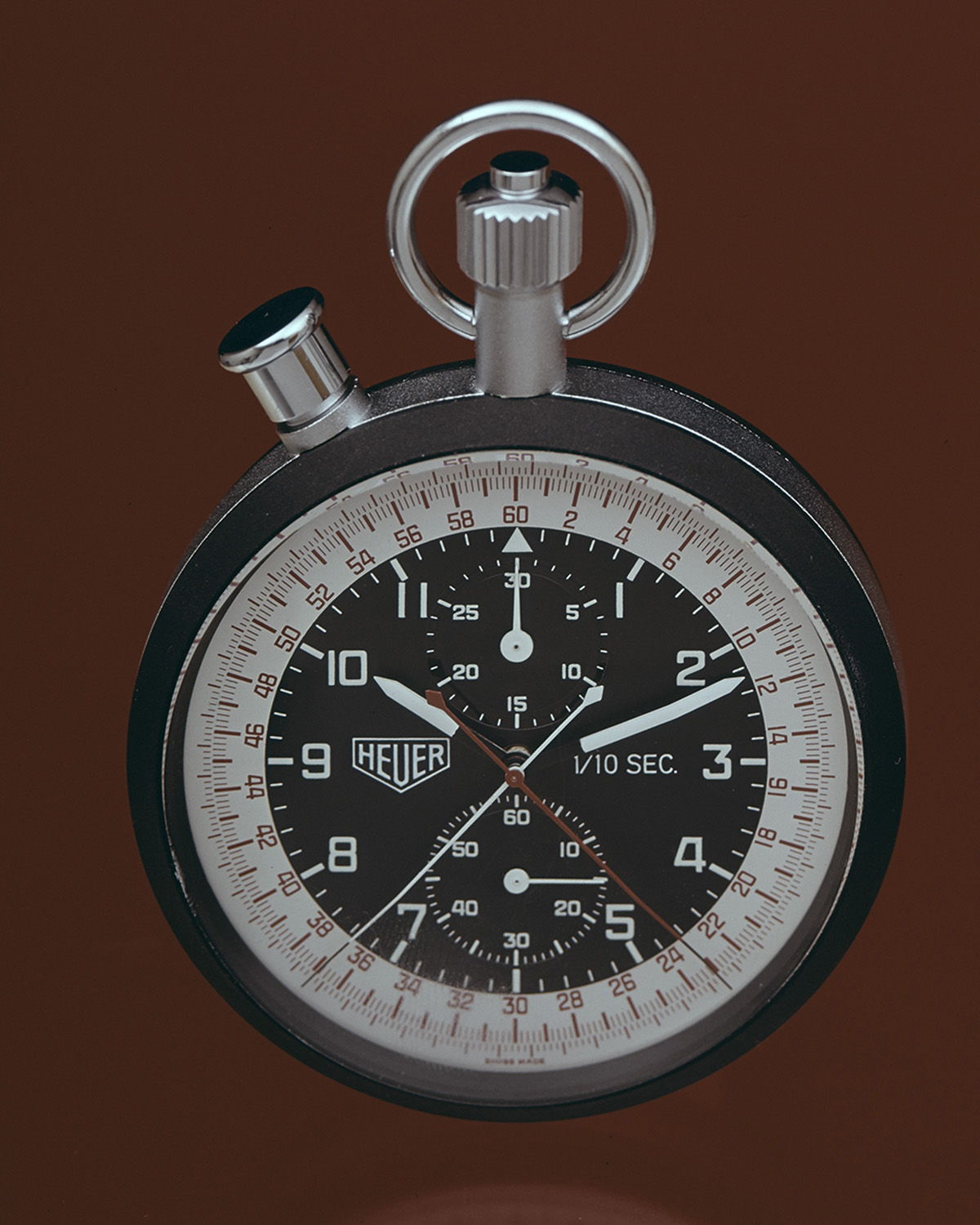
Reference 11.402
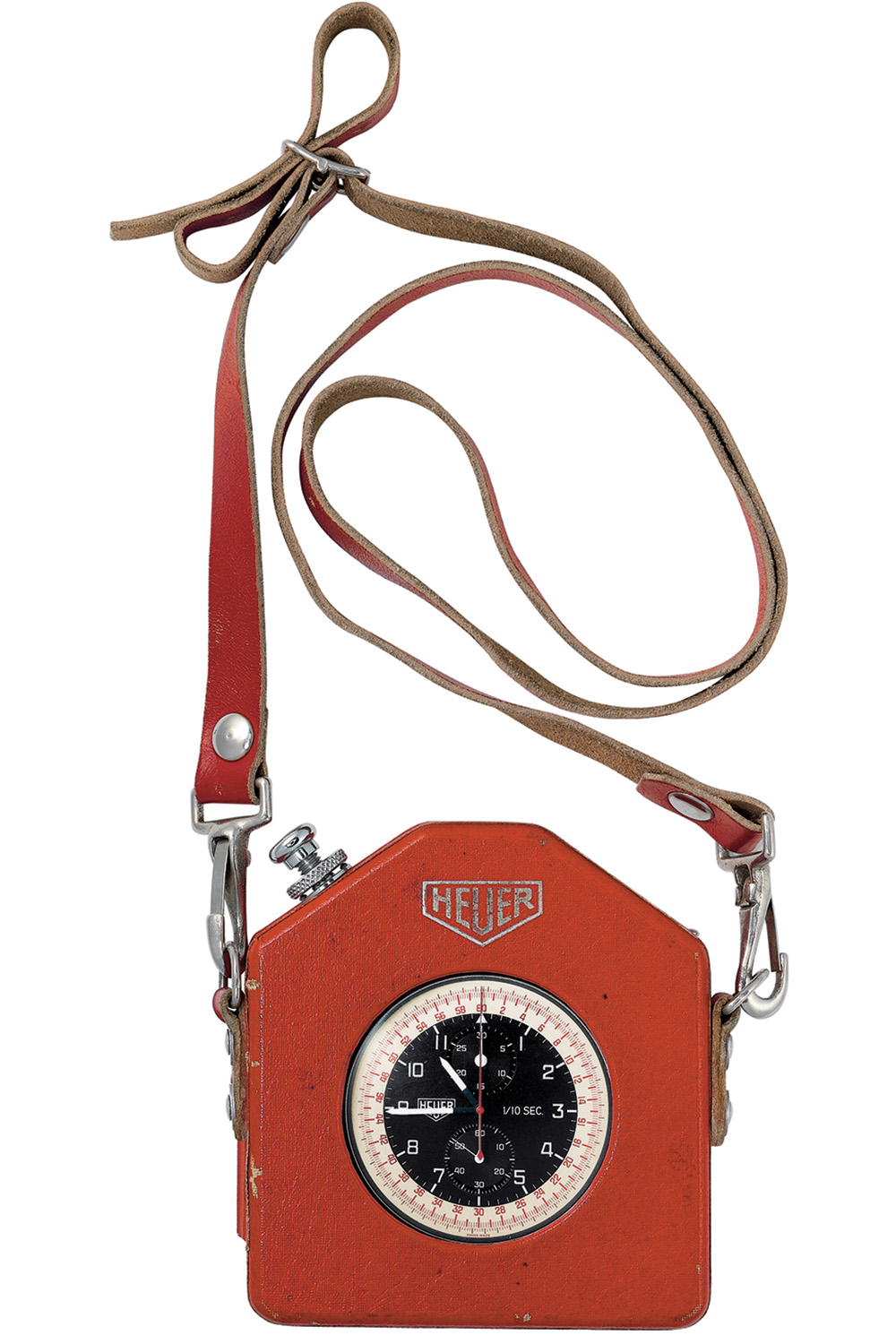
Heuer reference 11.402 was frequently spotted
around Formula One racing circuits, worn on a red leather case
Biebuyck mentions, “While the focus has very much been the utility of the product, we’ve always made watches that are extremely functional, precise from the beginning. More often than not, it meant that we were making a highend product. We used enamel dials because they didn’t age. We would use these beautiful, large diameter chronograph calibers from Valjoux that were also used as the base for Patek Philippe or Audemars Piguet or any of the major brands we know today. We would use the same suppliers as well.”
Even when the Swiss watch industry faced the onslaught of the Quartz Crisis in the 1970s, Heuer never wavered from its goal to continue keeping good time. Tapping into the latest technologies of the era, the company outfitted Enzo Ferrari’s own Fiorano circuit with 45 photocells providing the Italian racing maestro with the most optimal timekeeping system available. This tech-fuelled age also saw the introduction of the Heuer Microsplit 520 stopwatch which was the world’s first LCD pocket-size stopwatch accurate to 1/100th of a second. It was designed for Heuer by the German industrial designer Richard Sapper, who had said in an interview that “When the watch appeared on the market, it contained an electronic system that was three generations ahead of other watches; it worked better, only cost half as much, and required only a tenth of the space that I had originally planned for the watch’s shape.”
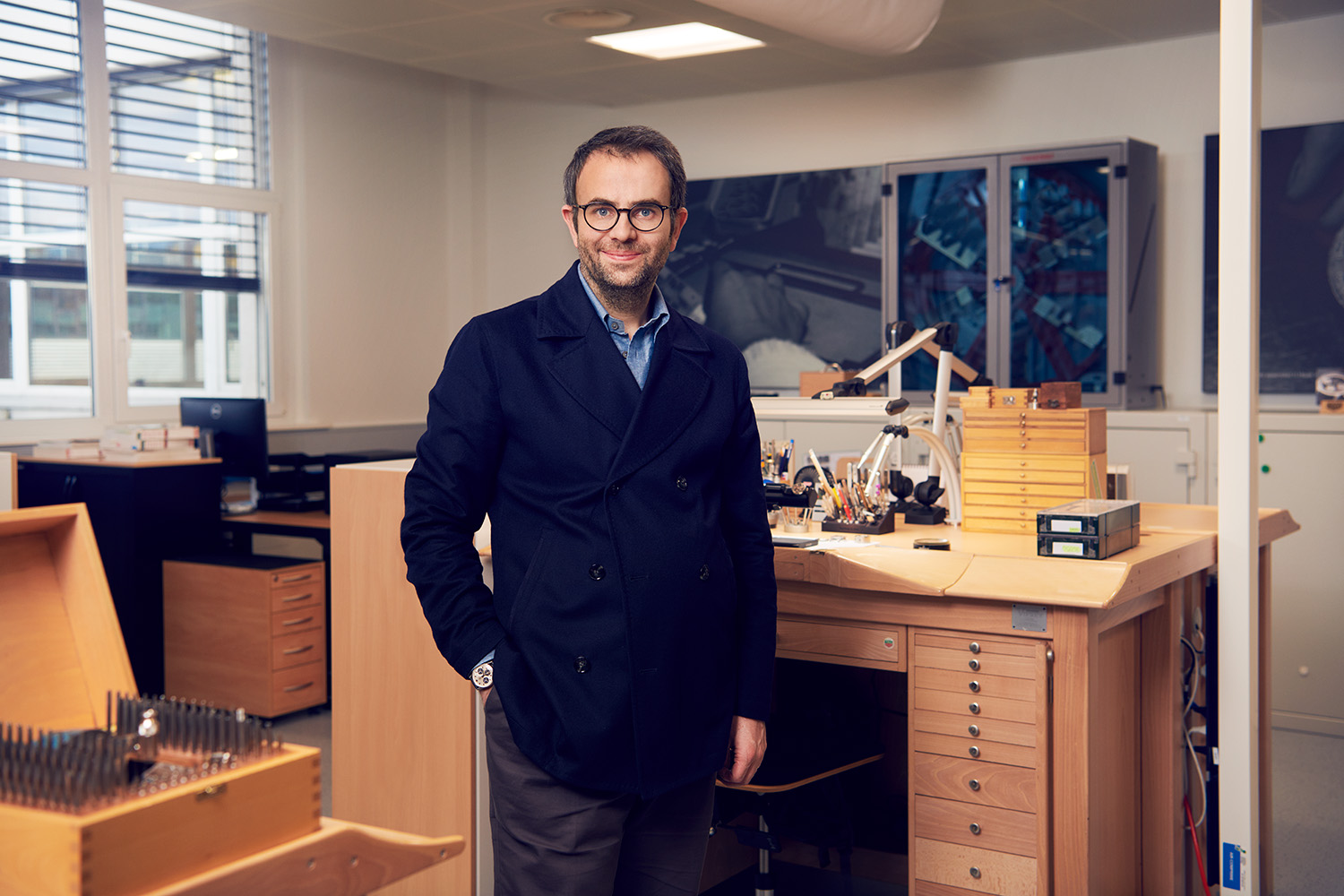
TAG Heuer heritage director, Nicholas Biebuyck
So TAG Heuer has this fantastic horological legacy that ranges from chronographs and split second chronographs to high frequency timekeepers, wristwatches and hightech precision devices. In addition, the company has consistently shown an incredibly innovative spirit that pushes it to create new and ever more functional solutions to improve upon existing methods of the time. At the same time, it often keeps civilian audiences in mind, creating timepieces (or versions of some timepieces) that were as relevant and appealing to the general public as they are to the specialist users.
These core values permeate the company to this day, as seen with its vast portfolio of products which includes affordably priced sporty chronograph watches available in both quartz and mechanical versions, in-house manufactured movements, legendary horological icons, connected watches and high concept haute horlogerie timepieces. Already well established within the entry-level segment, TAG Heuer is steadily rebuilding its haute horlogerie collection now with watchmaker extraordinaire Carole Forestier-Kasapi on board as the brand’s movement director.
In just three years since Carole Forestier-Kasapi joined TAG Heuer, she has enabled the brand to make great strides on all levels of watchmaking. A mechanical movement specialist, her name is irrevocably tied to some of the most technically creative haut de gamme timepieces ever made. But her technical ingenuity isn’t only restricted to the ultra high end as the work that she has done at TAG Heuer proves; Forestier-Kasapi’s unique brilliance lies in being able to understand the nuances of a brand and then creating watches that express its authenticity.
So here at TAG Heuer, this means thinking and rethinking the chronograph, and thoroughly considering the role of sports watches in society today. Very quickly, her direction on product development has allowed the brand to establish a dynamic new identity which can be immediately discerned whether through design, concept, technique or materials.
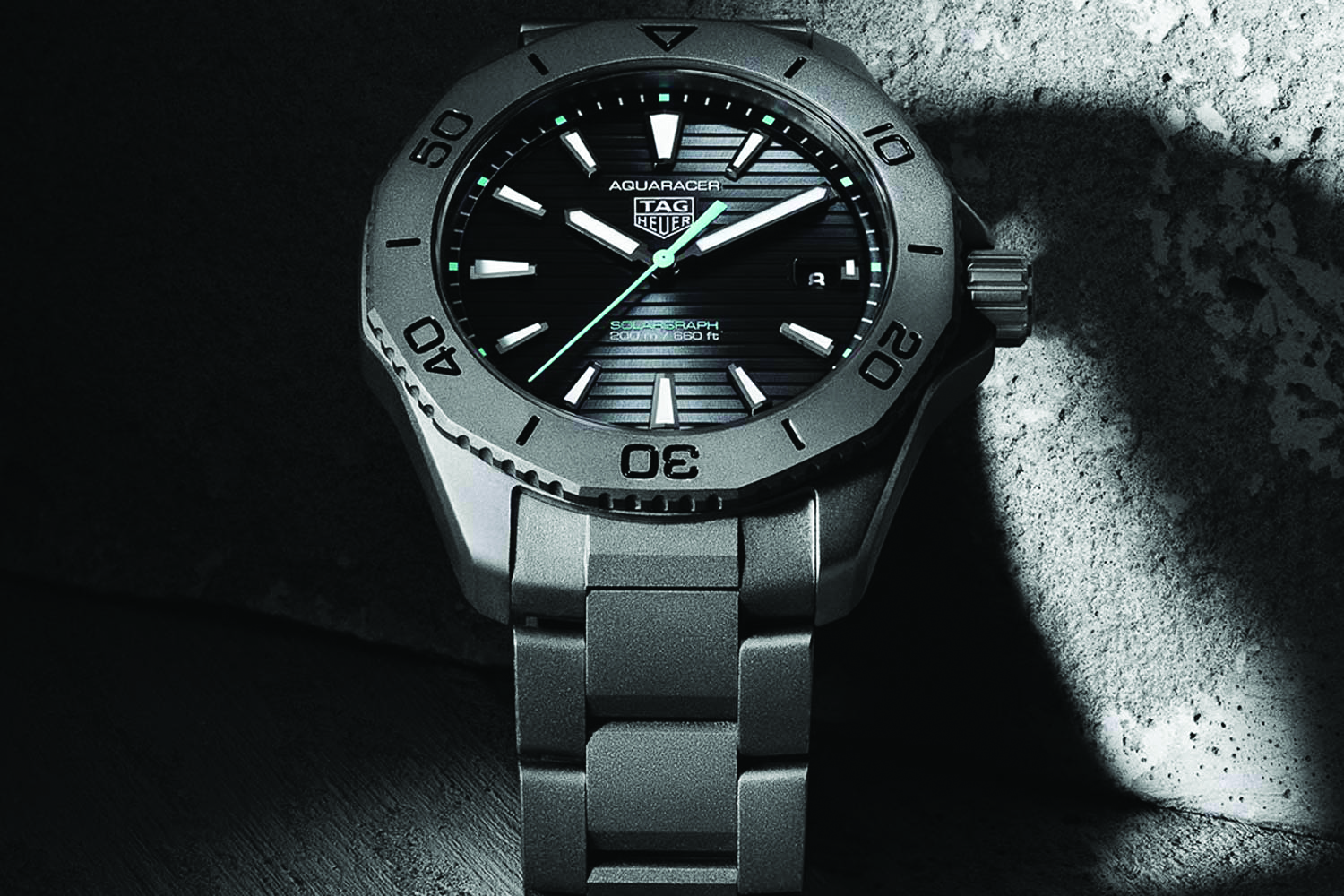
TAG Heuer Aquaracer Professional Solargraph
But of course movement development remains Forestier-Kasapi’s core area of expertise and on this front she has worked on TAG Heuer’s latest calibers such as the solar-powered TH50-00 developed exclusively with La Joux-Perret and featured in the Aquaracer Professional 200 Solargraph which works with natural and artifical light.
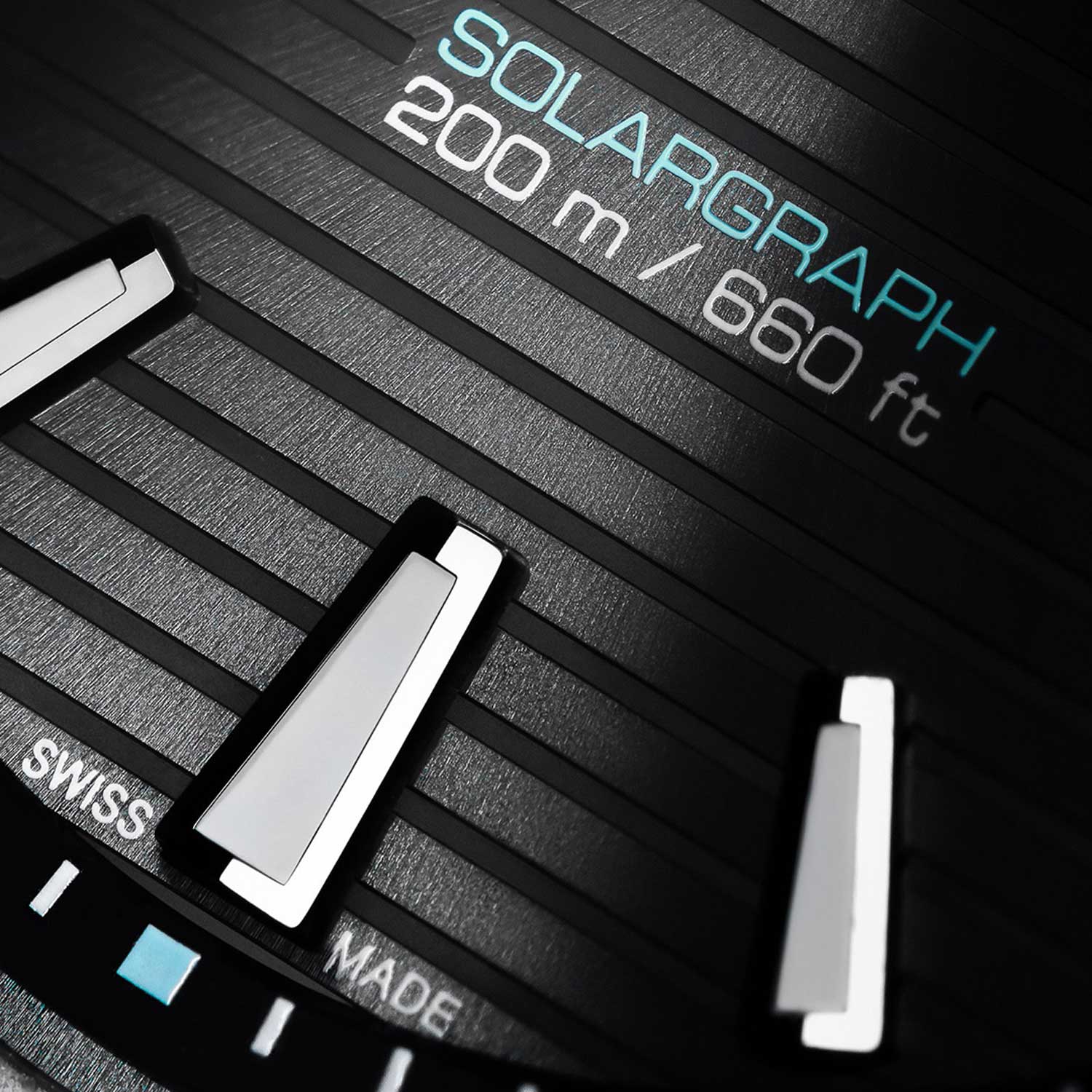
This quartz driven movement has an innovative solar module integrated within which is extremely efficient in that it requires just two minutes under full sunlight to keep the watch running for one entire day, and less than 20 hours to run for six months. Another recently introduced movement that flexed serious watchmaking chops is the caliber TH30-00 which emphasized TAG Heuer’s message on reliability and performance. This COSC-certified movement has an extended power reserve of 70 hours, rate accuracy of -3/+3 seconds per day, highly robust and built for sports. Produced exclusively for TAG Heuer by Kenissi, it is used in the Aquaracer Professional Superdiver 1000.
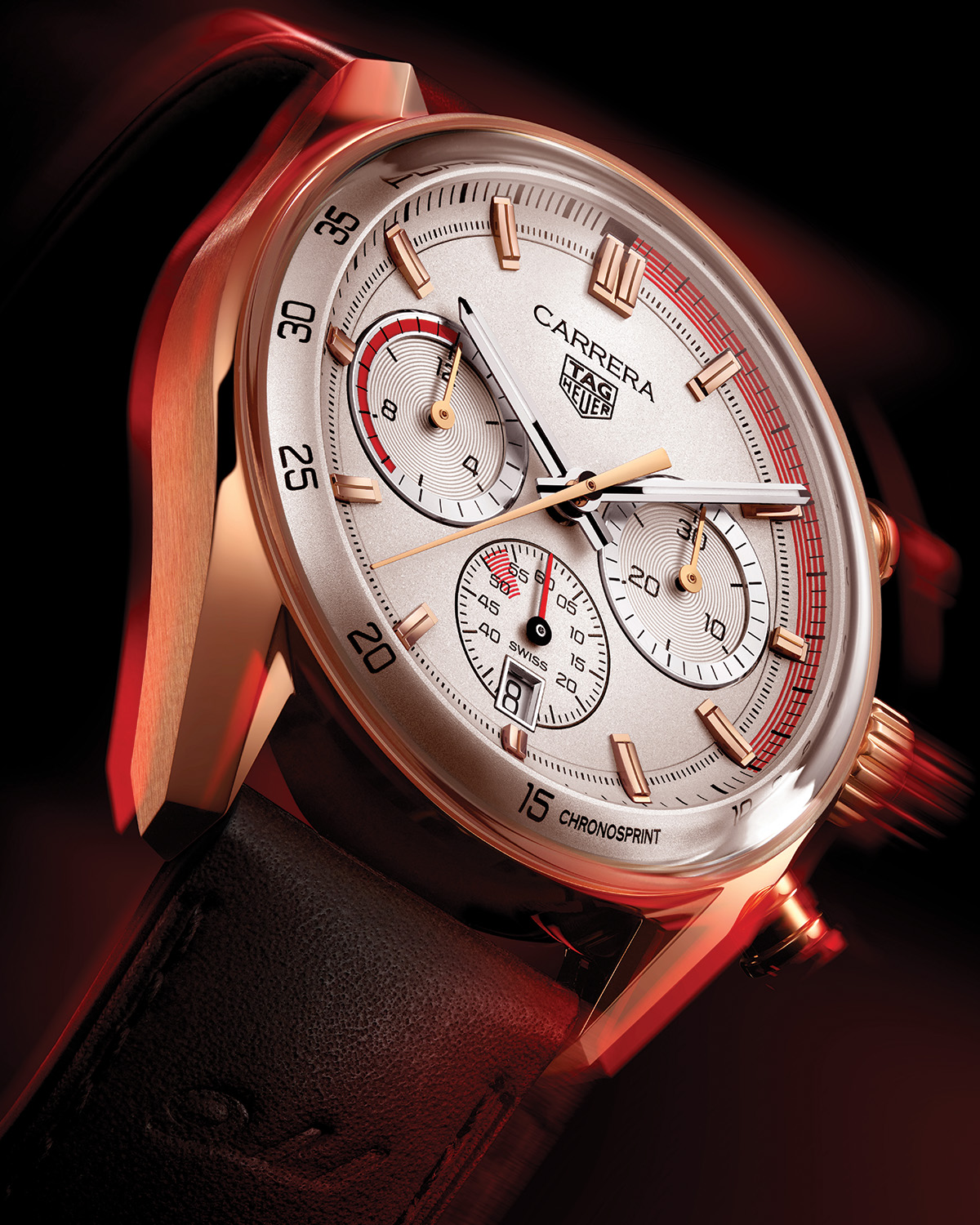
TAG Heuer Carrera
Chronosprint express a modern, innovative approach to horology
For both these movements, TAG Heuer pushed to achieve the best possible quality with the best possible technology. Nonetheless, Forestier-Kasapi’s natural penchant for the horologically extraordinary means we would also see her create some truly outstanding timepieces for TAG Heuer, and this includes the recently introduced
Carrera Chronosprint — a watch that appears clean, modern and sporty but offers a unique feature never seen in any other chronograph.
As this watch was created in tribute to TAG Heuer’s partnership with Porsche, its timekeeping mechanism mimics the Porsche 911’s acceleration of 0 to 100km/h in 9.1 seconds. The movement within is the caliber TH20-08 which has a chronograph wheel that rotates once per minute, but at different speeds throughout the minute. When started, the chronograph hand bursts into action, with maximum speed lasting just over nine seconds, before it gradually slows down to a standard cadence. To achieve this, Forestier-Kasapi designed an additional gear train in the shape of a snail at the end, using wheels crafted by LIGA.
In an earlier interview with Revolution, Forestier- Kasapi relates, “A few years ago, we proposed a complication really dedicated to Porsche. One of the most well-known things about Porsche is, of course, the 911. We proposed a chronograph linked to that, with the idea of measuring the 0 to 100 kilometers very precisely, which is very difficult with a regular chronograph. A regular dial is not precise enough. We explored enlarging the scale for the first 10 seconds. We didn’t want to have a chronograph that just measured 10 seconds rather than 60 around the dial, so we explored enlarging just a specific area, and arrived at a solution where we had a running seconds hand with variable speeds over the course of a minute.”

Carole Kasapi, TAG Heuer’s movement director
Evidently, Forestier-Kasapi’s futuristic style of watchmaking is a perfect fit to the TAG Heuer DNA. Never a fan of re-creating something from the past, Forestier-Kasapi mentions over and over again that she deeply believes in making watches that represent the mindsets of today and always with a view of tomorrow.
She adds, “The strategy is for the maison to have a catalog of movements that offer better quality and durability. This is really what we have to target; this is the new normal for the Swiss luxury market today, and absolutely essential to offer tomorrow — better durability and quality for our clients.” This renewed commitment to conceptualize movements and later on high complications can be seen in every novelty watch the brand has made in the last three years. After all, the first three letters of its name does stand for Techniques d’Avant Garde and so what would TAG Heuer’s raison d’être be if it wasn’t to push the envelope in contemporary timekeeping?
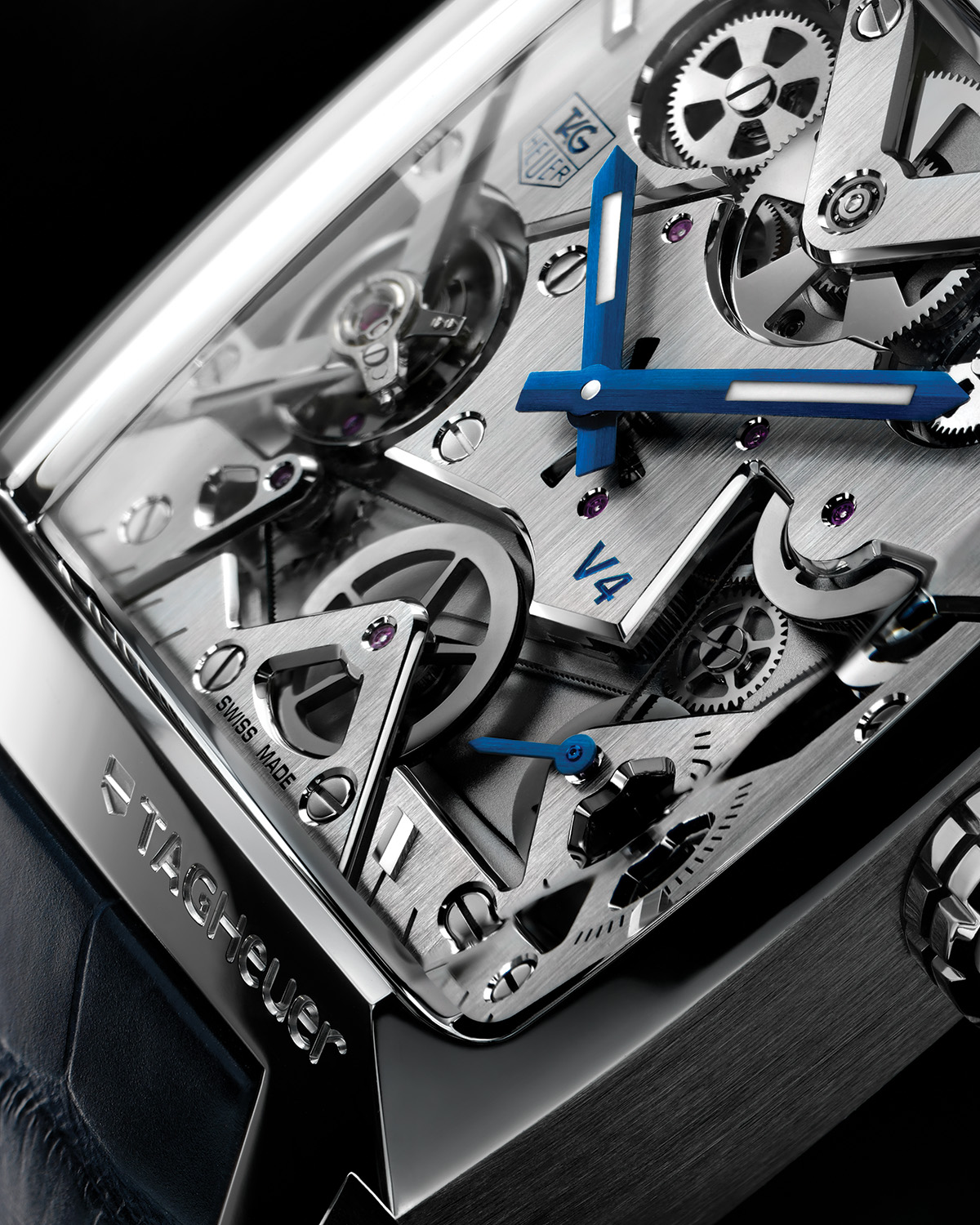
Introduced in 2004, the
Monaco V4 uses a belt-driven transmission in place of a traditional gear train
Watch aficionados remember when TAG Heuer was especially progressive during the mid 2000s to the 2010s, having built a formidable stable of highly progressive mechanical movements. Innovative solutions on ever higher oscillating frequencies and state-of-the-art oscillator designs which include even a watch known as the Pendulum Concept that does away with the balance spring entirely, using magnetic fields in its place.
By this time TAG Heuer was already hailed as a revolutionary watchmaker, celebrated for thinking far outside the box and daring to rethink conventions. The Monaco V4 of 2004 for instance proffered the idea of replacing traditional gears and pinions with a belt-driven transmission, while the Monaco Twenty Four demonstrated a novel solution to house the movement. The high frequency 5 hertz caliber 36 is suspended within a square case crafted in titanium carbide that is extremely shock resistant thanks to what it named the Advanced Dynamic Absorber system. Four steel tubes keep the movement protected from impact, absorbing vibrations from the movement as well as external shock.
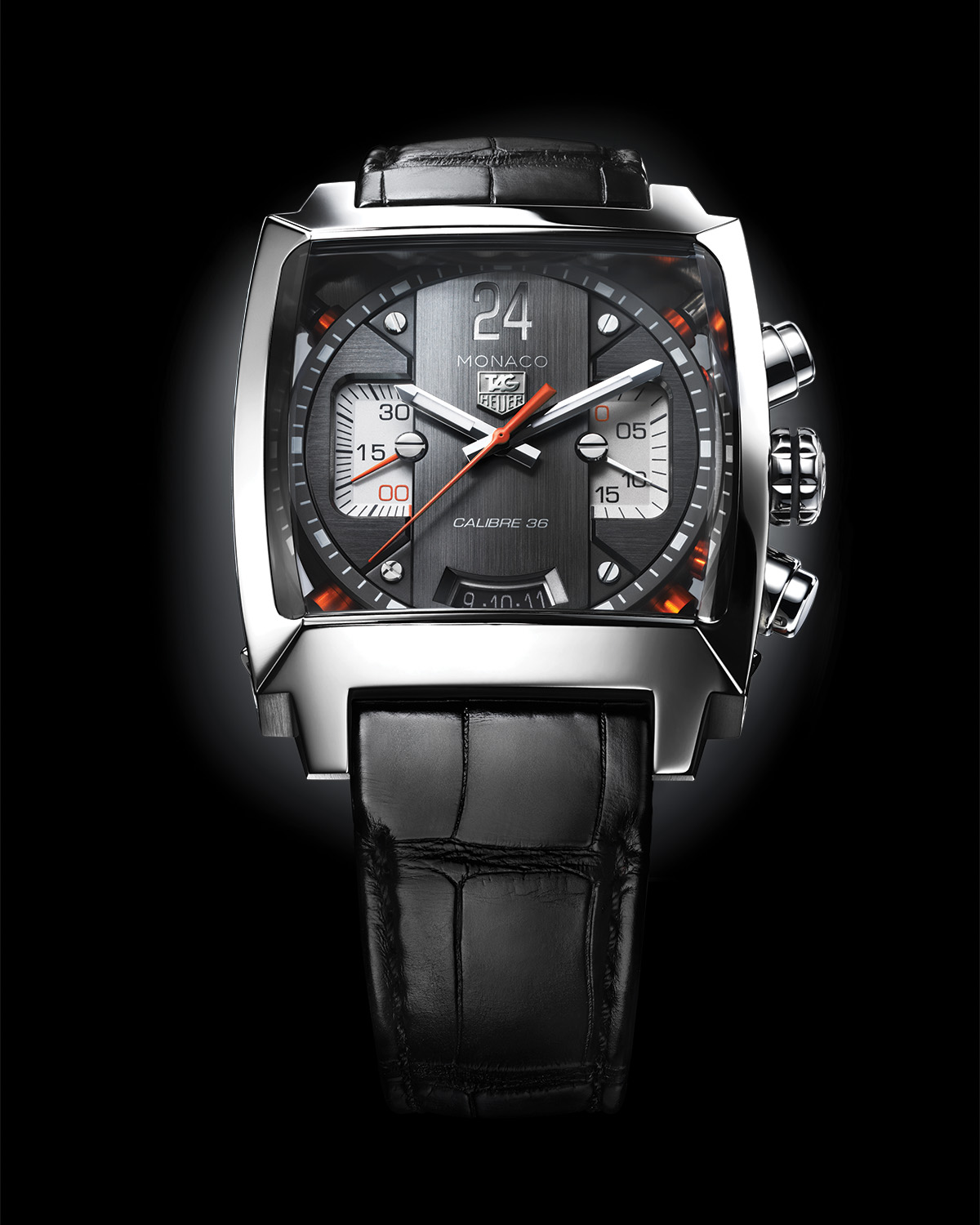
Monaco Twenty Four Concept
As we progressed into the 2020s, TAG Heuer made a unique full
carbon Monaco for charity in 2021 which uses this exciting material not just for the case, movement and dial, but the hairspring as well. Being completely insusceptible to magnetism, TAG Heuer’s carbon nanotube hairspring presents itself as an alternative to silicon hairsprings in that carbon is ultimately lighter than silicon, and therefore less likely to deform as a result of gravity.
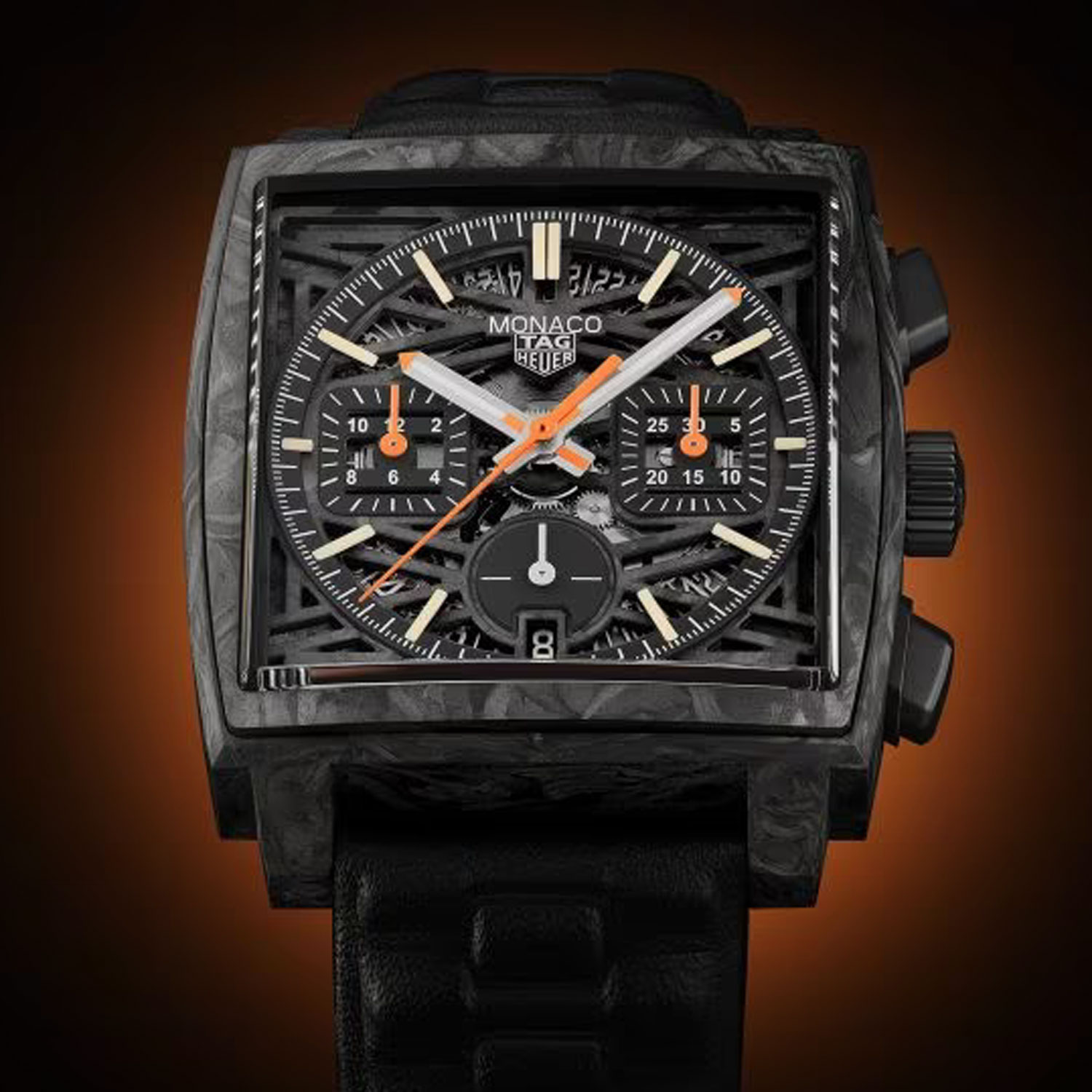
TAG Heuer created a unique piece Monaco Dark Lord for Only Watch 2021
Taking all of its experiences and discoveries from this unique piece, TAG Heuer embarked on an ambitious quest to create its most complex chronograph wristwatch to date — a watch that has been a long time coming — the Monaco Split Seconds Chronograph.
TAG Heuer Monaco Split-Seconds Chronograph
As we’ve mentioned earlier, the rattrapante complication is the pinnacle of chronographs. Infinitely more complex than the classic chronograph — which by the way is no cakewalk to create from scratch — the rattrapante chronograph was a natural choice for TAG Heuer as the next big step to take. After busying itself for years bringing technical innovation to the most delicate components of a movement, the time has come for TAG Heuer to revisit functionality in high complications. And given its strong ties to some of the earliest mechanical split second stopwatches in history, such a timepiece would only make perfect sense.
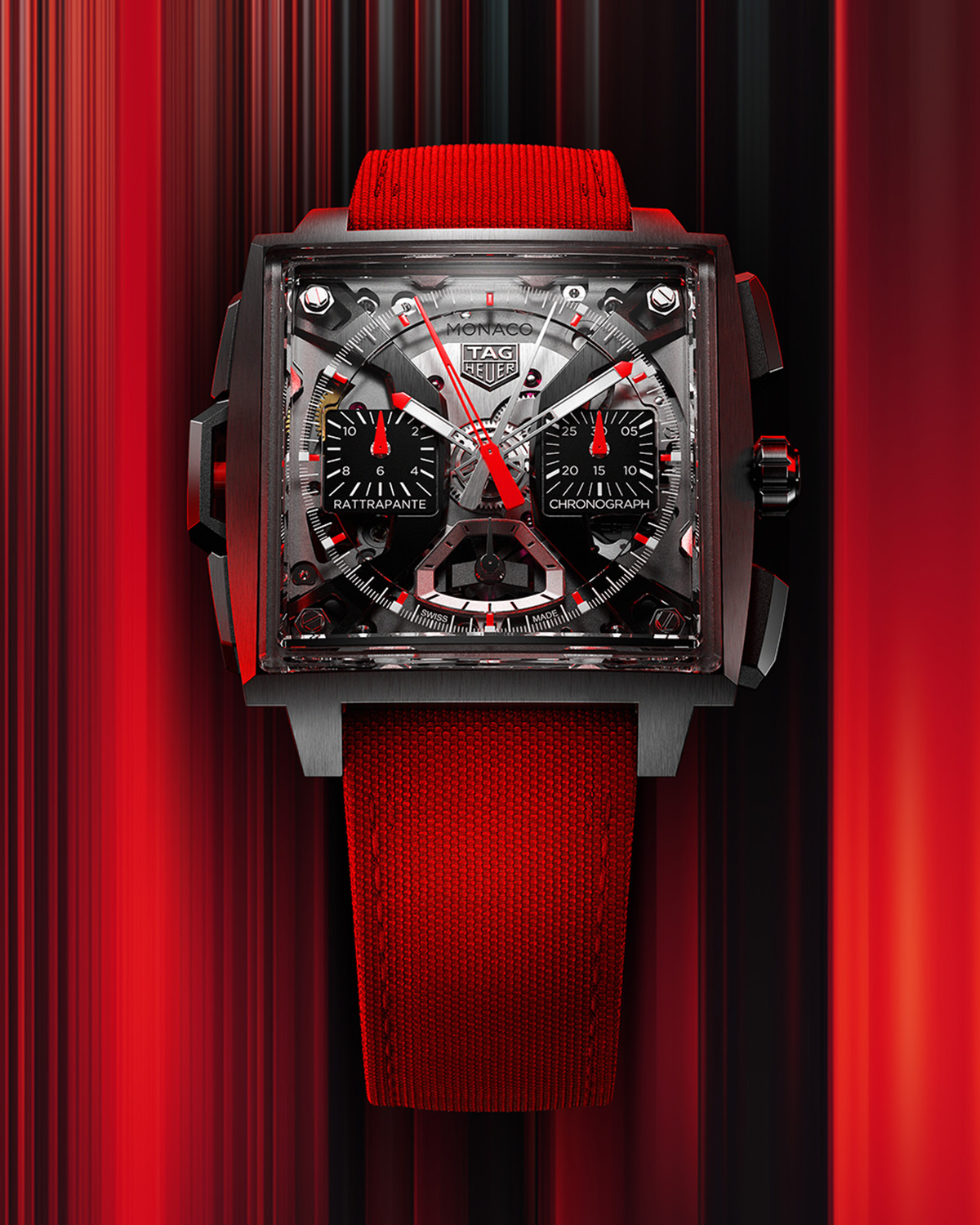
Monaco Split-Seconds Chronograph is the first Rattrapante wristwatch by TAG Heuer
However, it was a decision not taken lightly, as Biebuyck relates, “After the 2021 Only Watch, we wanted to think a bit longer and harder about what we could do for 2023 that would be even more distinctly TAG Heuer. That would allow us to play with a new direction for the brand. So Carole, myself and Fabrice [Deschanel of Artime] would have these once-a-week reflections on high end watchmaking and what it meant to TAG Heuer.”
The trio would go through every individual high complication, every chronograph, every repeater, escapement device, and perpetual calendar in the book, asking themselves if that would be suitable for TAG Heuer. If the answer is yes, then a deliberation process ensues where they would contemplate such details as how that watch would look like. Along the way, Biebuyck reveals that they’d uncovered many great ideas, but that a lot of them would be unveiled over the mid to long term. What became much more certain, however, was TAG Heuer’s unrivalled longstanding affinity with the chronograph. “We are synonymous with the chronograph,” he states. “We are the chronograph brand. In fact, during the 1950s, Jack Heuer and his father made the decision to discontinue timeonly watches because they understood their competitive edge as the chronograph brand.”
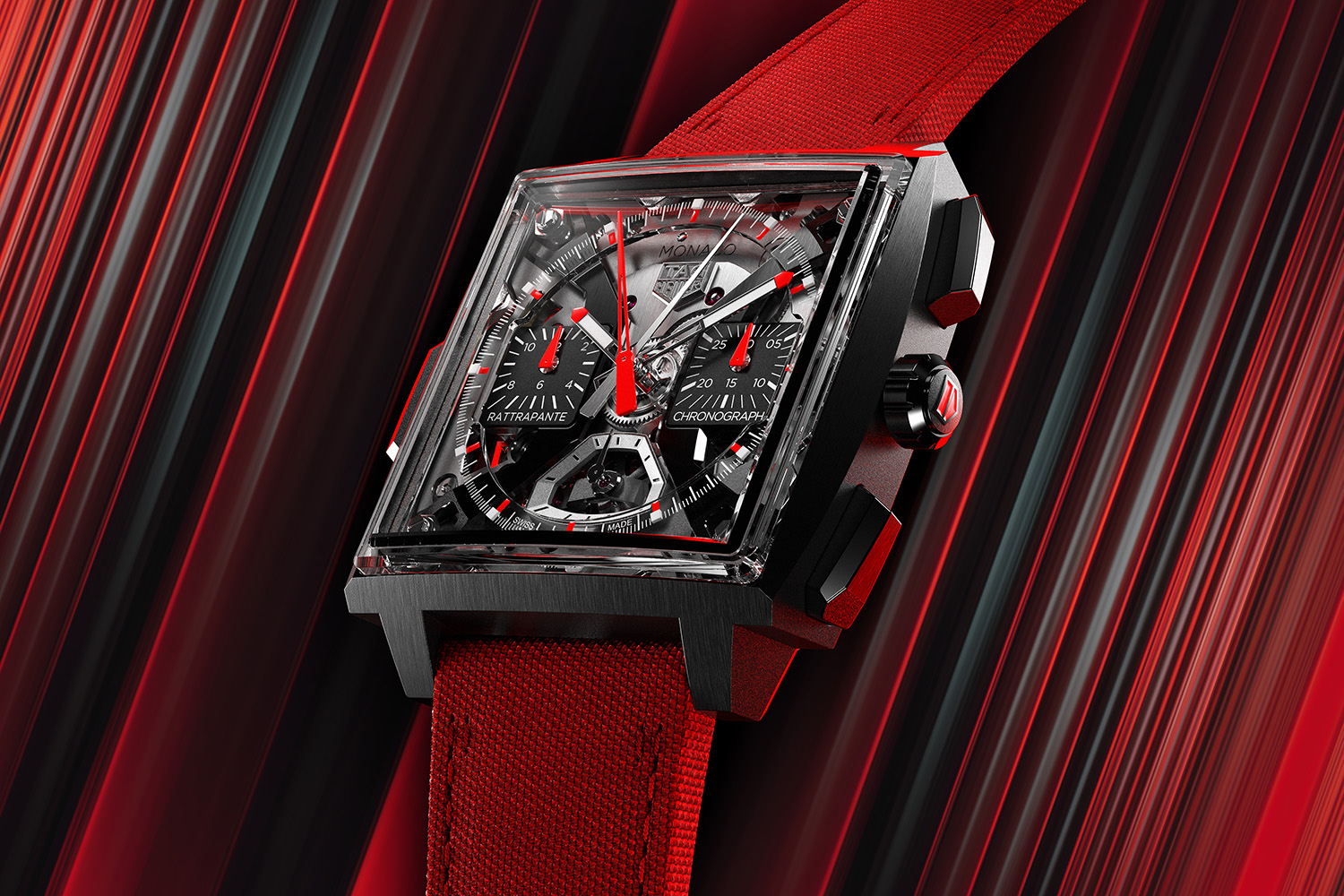
The entire case construction uses exclusively titanium and sapphire crystal
Yet as soon as they found their answer came the first hurdle in their monumental journey. Even though the company had made mechanical split second chronograph stopwatches in the past, it had not done a split second mechanical wristwatch in the present. It would undoubtedly have been extra wonderful to build a new split second movement from scratch but that would take three to five years minimum, and the reality was that there exists a perfectly ideal base chronograph caliber on the market that checks all the right boxes. The Vaucher caliber 6710 was well homologated, well tested, relied on by many ultra-premium brands, and with enough in numbers to go around. Plus, they’ve got Forestier-Kasapi on the team. With her decadeslong experience as a movements specialist and extensive knowledge of haut de gamme watchmaking, working with Vaucher meant enjoying all the pros and none of the cons.
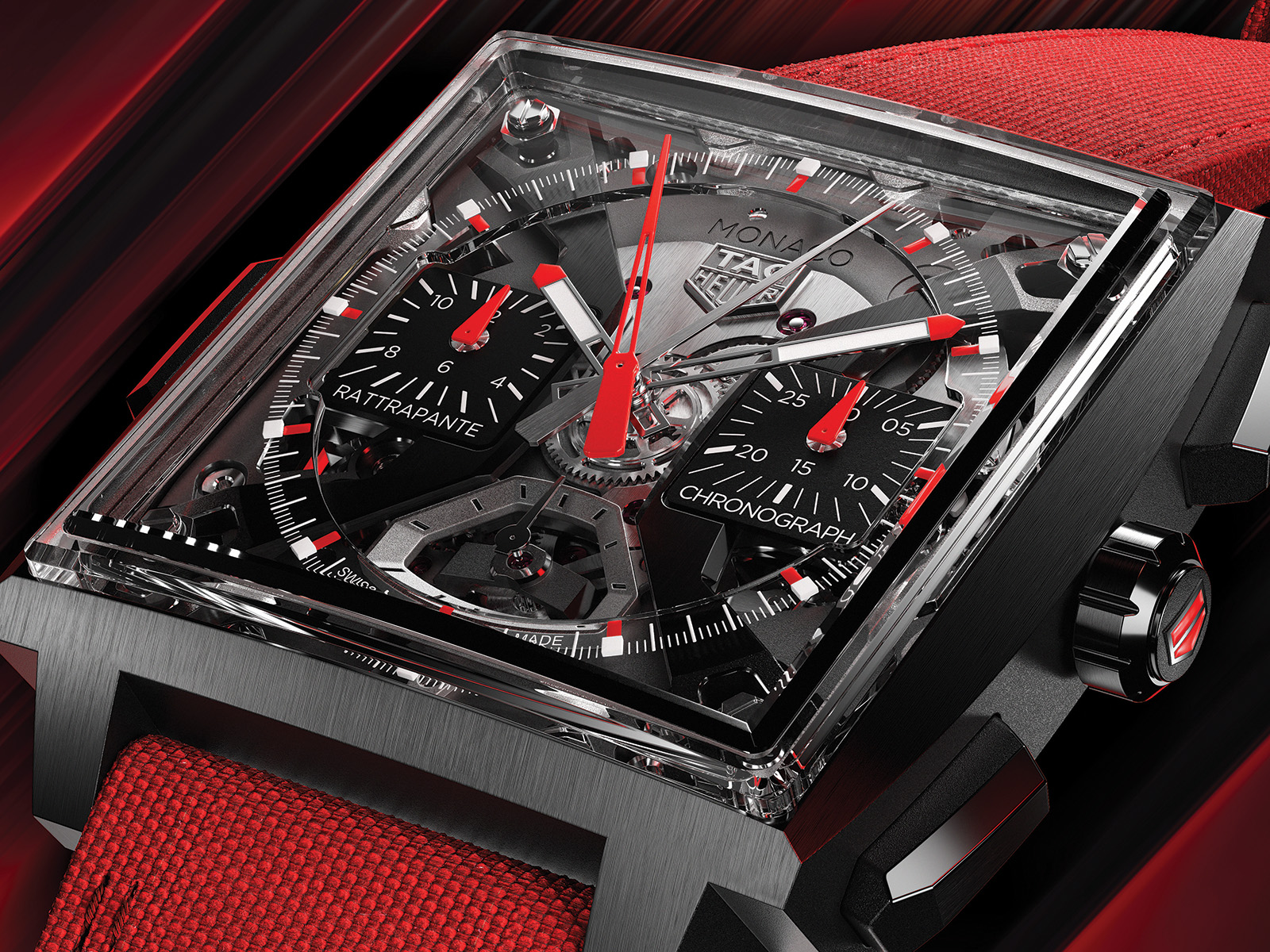
TAG Heuer used titanium for the movement for a total weight including strap of 85 grams
Naturally, TAG Heuer didn’t merely purchase the movement “off the shelf” or use it as is in the watch. Biebuyck stresses that it had been a true collaborative manufacture caliber, with key improvements and fine tuning applied to the end product. He says, “One of my biggest frustrations with the movement is that it has this huge bridge on the back for the automatic winding that covers nearly all of the movement. So I said ‘What can we do to make this as small as possible?’ This made a big difference for our movement and it was important for us because we only wanted the crème de la crème for this piece.”
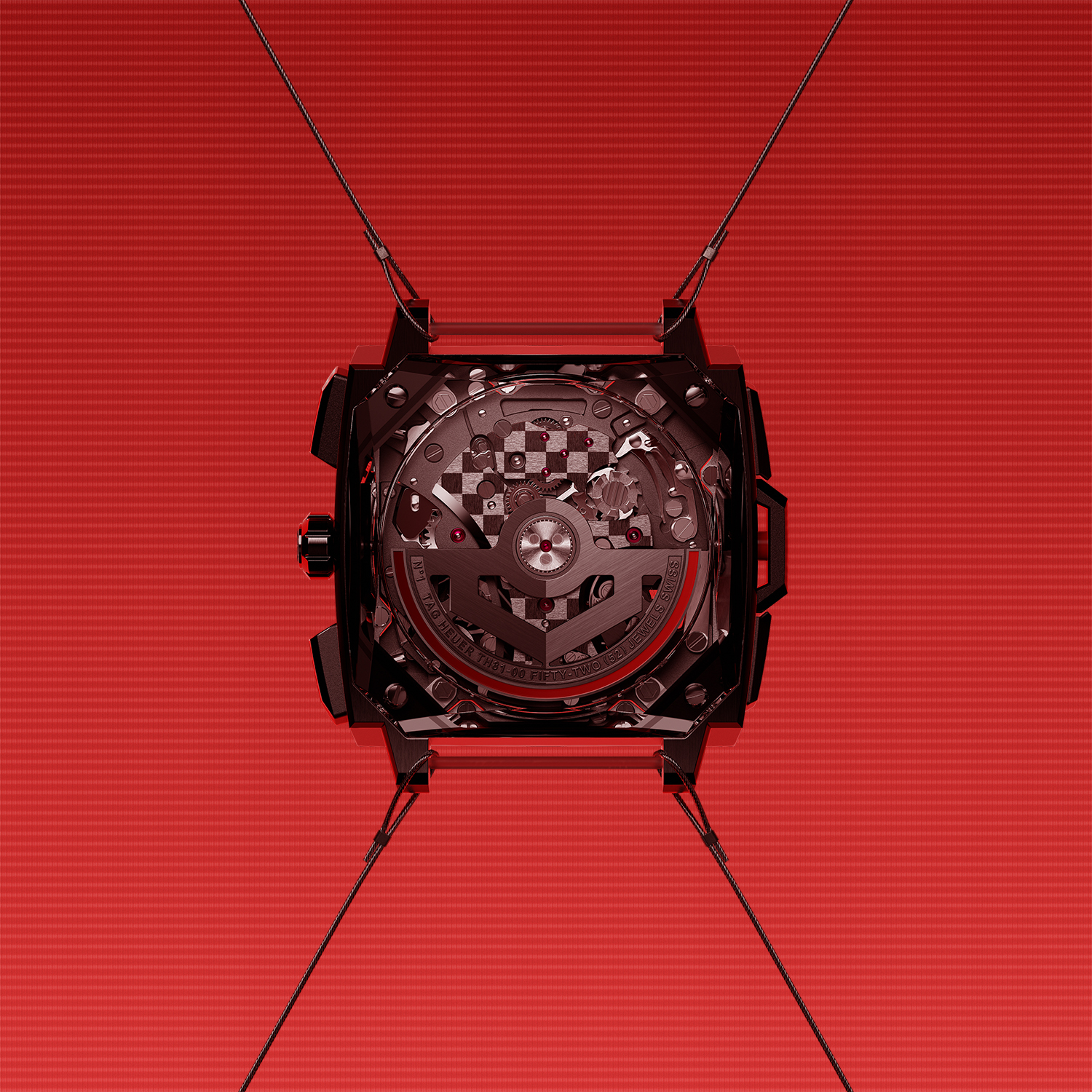
TAG Heuer collaborated with Vaucher for the movement and worked with Artime for the finishing
This resulted in caliber TH 81-00 with a super sporty and ultra futuristic design where the center bridge has not only been redesigned to not obscure the movement, but it was also hand-decorated with a distinctive checkered flag pattern as a sort of clin d’oeil to automotive racing. The entire movement has been made of black matte titanium, complete with hand polished bevels and fine-brushed surfaces on the bridges and oscillating weight, which has a striking red line hand painted in a semi-circular arc drawing closer references to the world of competitive motorsports.
It could not have been easy as it took about 80 hours of hand finishing for the movement alone. Both the visible and non-visible parts have been finished and decorated for TAG Heuer by Artime Créations, a movement specialist atelier comprising some of the best technical minds in the watchmaking world. Biebuyck shares, “It was like an AP R&P reunion because we had Stéphane Maturel and his team at Artime, Stéphane Oes of Vaucher, Angelique who was in charge of CAD homologation, and two members from our development team Pierre and Claude. There were some pretty tense moments with the development team but it was also a real baptism of fire that really brought us all closer together.”
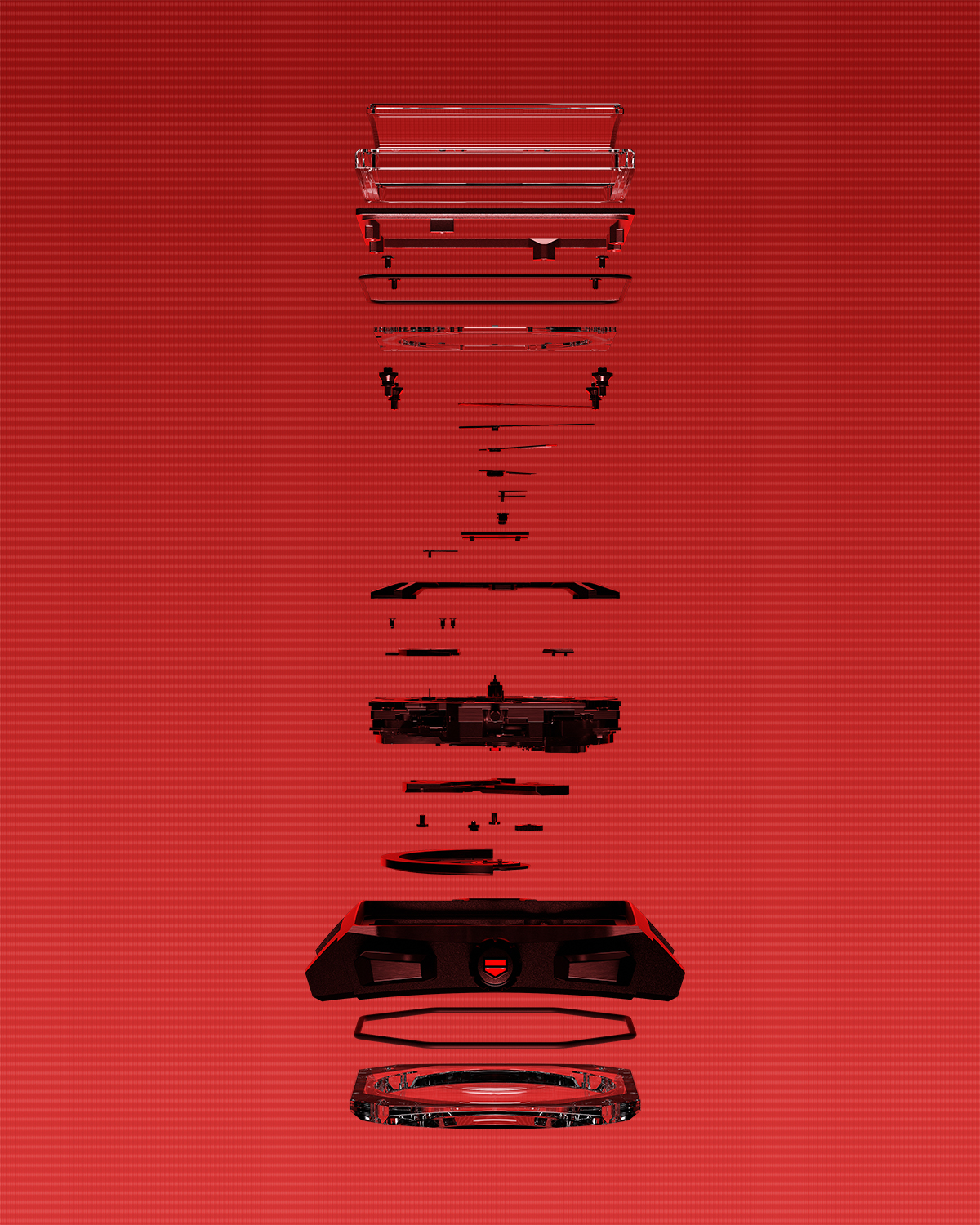
The case structure remains faithful to the original Monaco 1133B
Says Forestier-Kasapi, “I think it’s a very good movement and it was evident for us because this movement is conceived in a modern way. For me this movement matches with what clients today expect in terms of durability and in terms of quality. These two aspects were what we really wanted to emphasize with this creation.”
No detail escapes Forestier-Kasapi’s attention, and every element of the Monaco Split-Seconds Chronograph was taken into careful consideration. She elaborates, “We wanted to work around the complication made for sport, so it needs to be ergonomic, and that’s why you see that we’ve placed the rattrapante pusher at nine o’clock. Although yes it is also another clin d’oeil to the original Monaco with its crown at nine.” Using titanium and sapphire for the case and the movement, coupled with a textile-patterned handstitched calf leather strap and titanium deployant clasp, the Monaco Split-Seconds Chronograph weighs an astounding 85 grams all in. So even though TAG Heuer drew direct inspiration from the original Monaco reference 1133 for this piece, subtle refinements have been applied throughout the watch to assure an ergonomic fit.
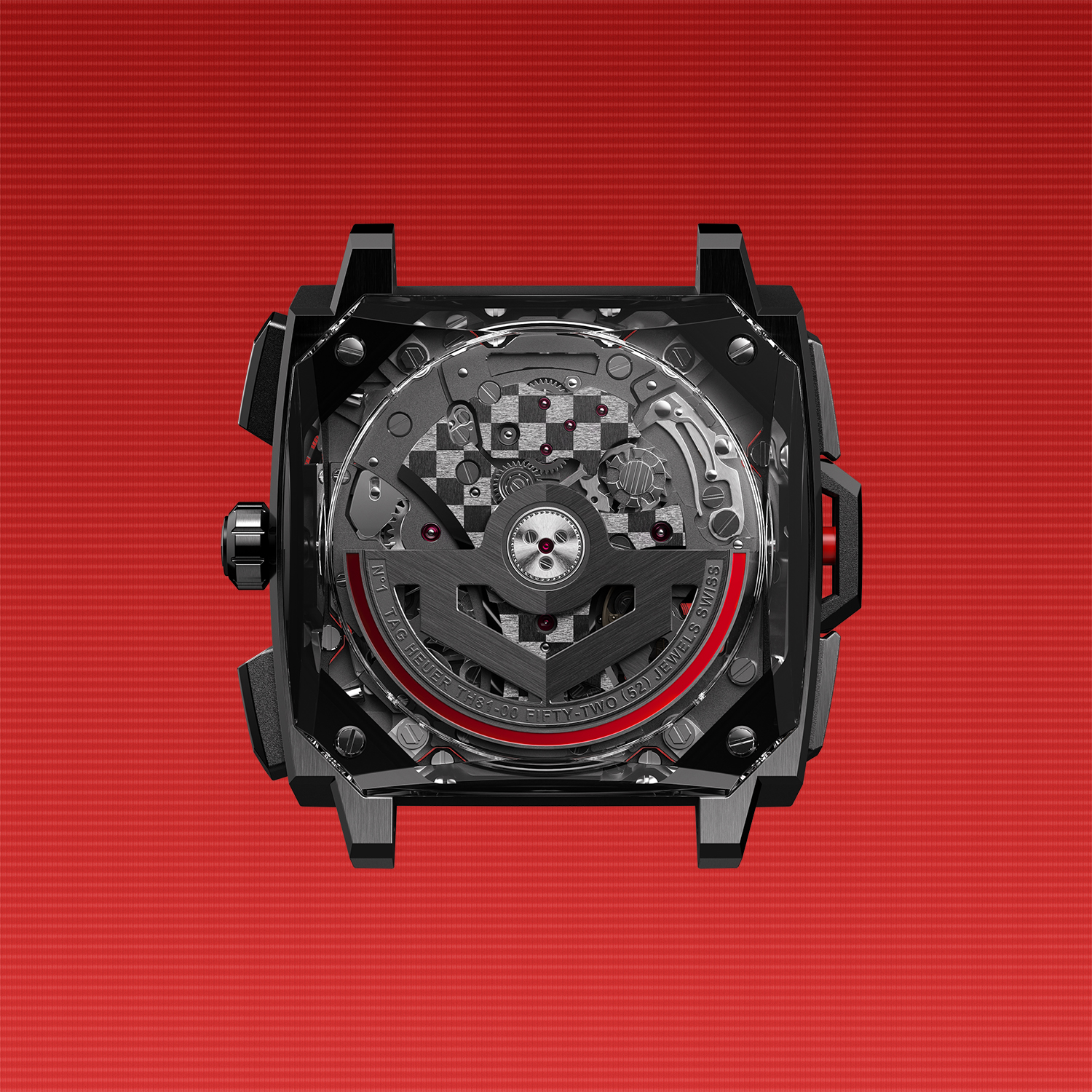
Caliber TH 81-00 emphasises TAG Heuer's rich heritage with the chronograph and precision timekeeping
TAG Heuer’s senior product designer Julian Delcambre sought to model the original Monaco in 3D, fit in the new Vaucher split second chronograph movement, and the reduced the overall height of the case while keeping distinctive elements such as the tips of the lugs and the edge limits of the main case. Arriving at a totally modernized and updated aesthetic, he incorporated clever details that work towards enhancing comfort. “When you have the watch on your wrist, there is only a very small contact area so it doesn’t feel as big as it actually is,” notes Biebuyck.
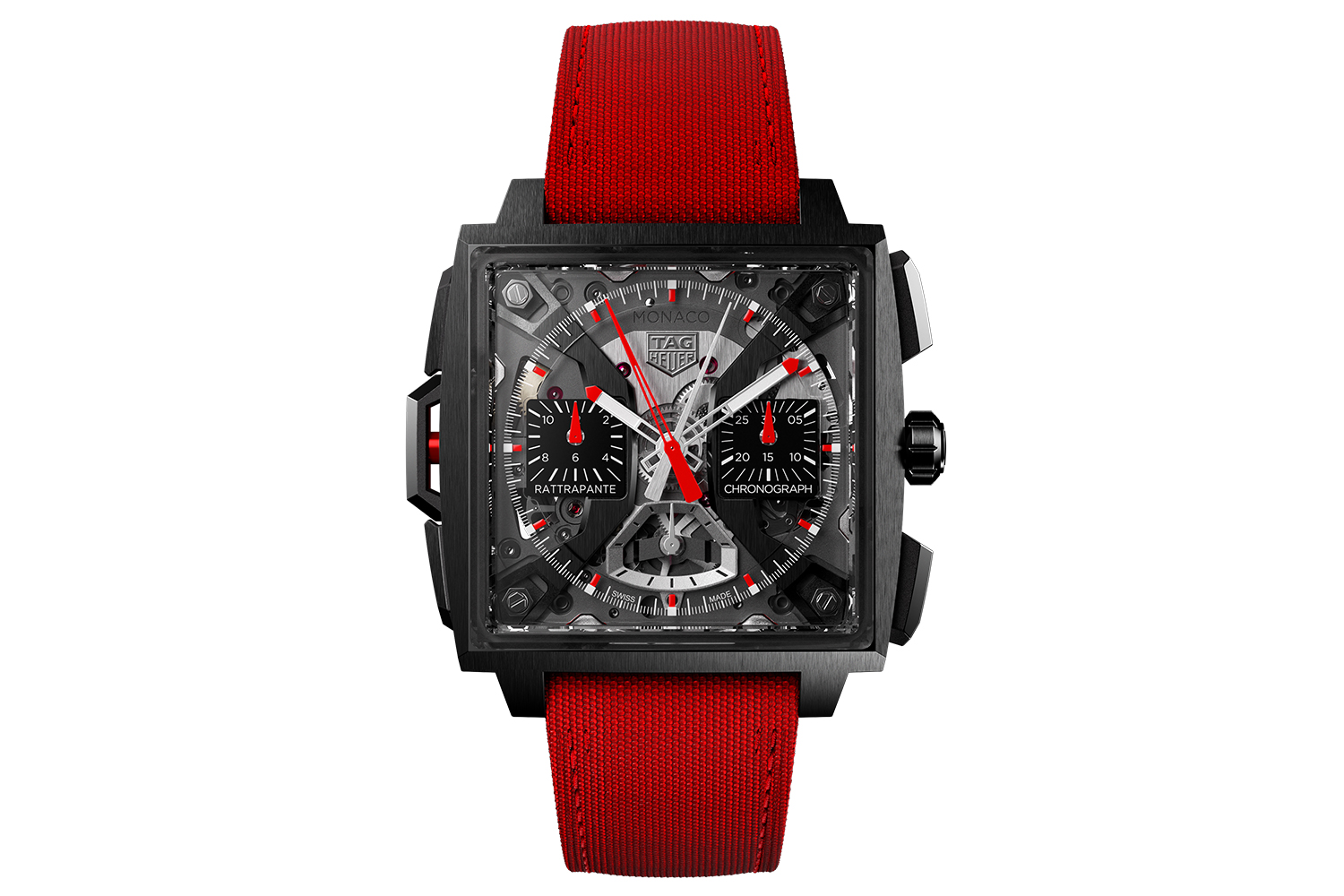
With the Monaco Split-Seconds Chronograph, TAG Heuer back to the realm of haute horlogerie
The sapphire crystal is also gently domed, with sloping sides to provide a slimming effect, and the sapphire bezel that is perfectly transparent against a case which Forestier-Kasapi describes as, “like a hybrid case, because it is 50% in titanium and 50% in sapphire. The curved case back fits perfectly and because the watch is equilibrate in terms of weight, it doesn’t shift around when worn on the wrist.” In fact, everything hinged around the watch’s sapphire components which were validated even before the case design was finalized, in order for it to grow in time. Moving in such an agile way was crucial in ensuring that the Monaco Split-Seconds Chronograph would finally see light of day, because this was a product made without compromise.
Biebuyck reflects, “Carole and I had a very simple philosophy on this, whether it was the case, the movement, the sapphire, the strap, the buckle, or who we wanted to work with on the finishing. We asked ourselves who is the best? Who is the ne plus ultra? Who is close to us in Switzerland? Who do we have a great relationship with? Whom can we building something now and for the future? That was the guiding philosophy.”
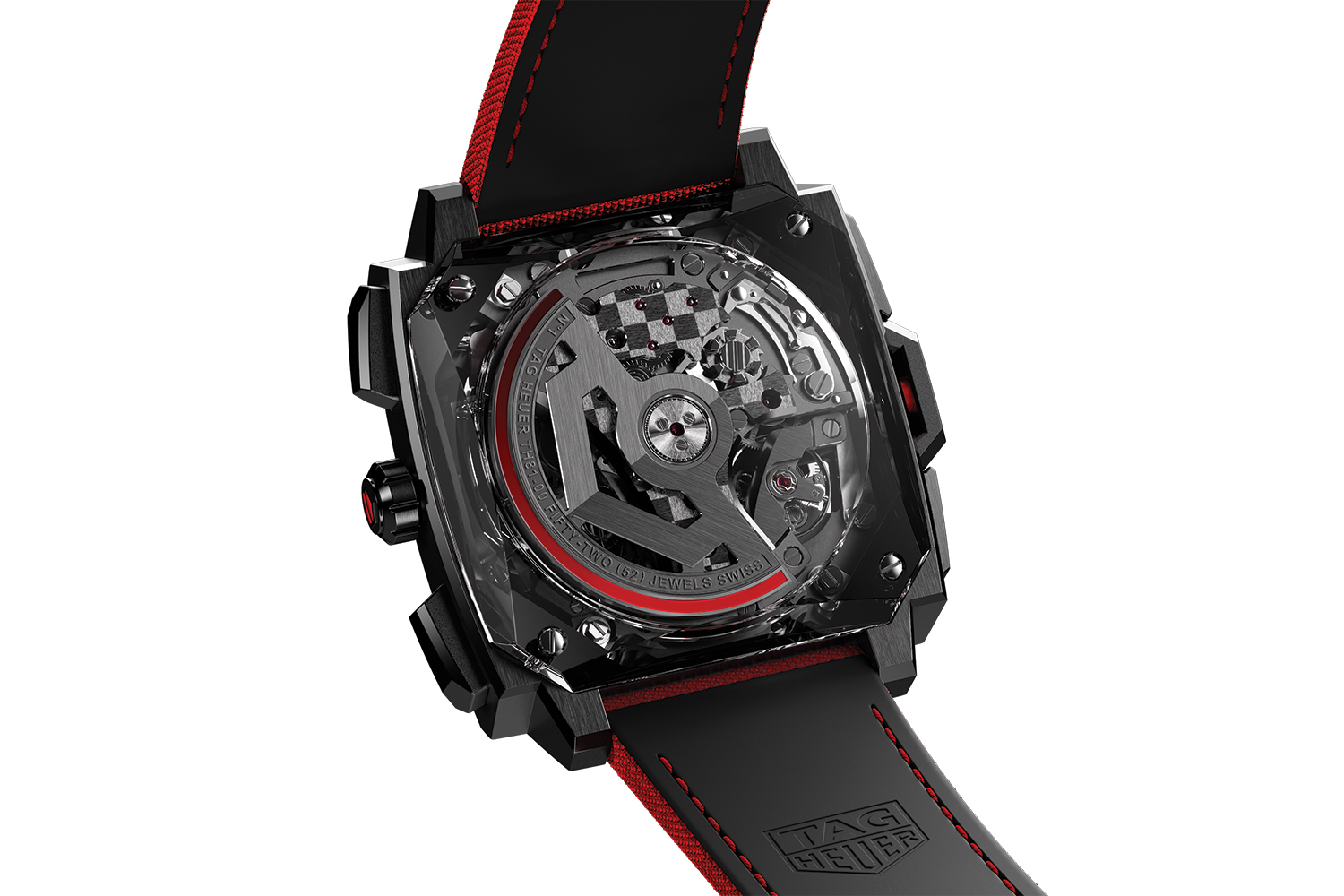
The watch evokes a strong automotive spirit both inside and out
The Monaco Split-Seconds Chronograph sits right at the apex of TAG Heuer’s existing stable of wristworn timekeepers. Priced at CHF165,000 and issued in numbered pieces based on a limited production, collectors will be offered some degree of customization on the watch. Options include color accents, specific finishes of the titanium case and chronograph sub-dials, and design elements of the oscillating weight. Shaping the haute horlogerie future of TAG Heuer with its sophisticated aesthetics and unassailable technical finesse, this sporty complication timepiece sets the bar high for future pieces that are certain TAG Heuer used black titanium and sapphire for the case and titanium for the movement for a total weight including strap of 85 grams to follow.





























